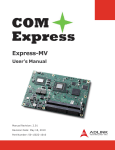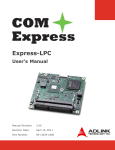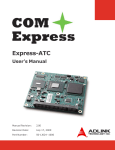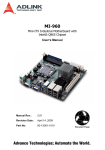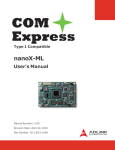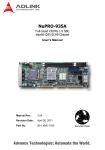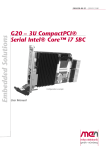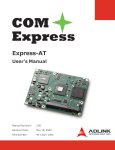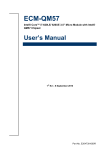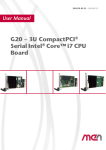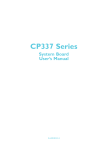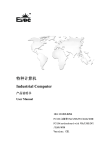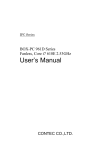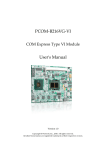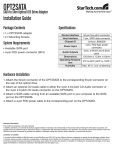Download Express-CB/CBE User`s Manual
Transcript
Express-CB/CBE User’s Manual Manual Revision: 2.01 Revision Date: February 22, 2011 Part Number: 50-1J033-1000 Revision History Page 2 Release Date Change 2.00 2.01 Nov. 26, 2010 Feb. 22, 2011 Initial Release Update pinouts, add content for Express-CBE Express-CB User’s Manual Table of Contents Preface ............................................................................................................................ 5 1 Introduction ............................................................................................................... 7 1.1 Description ........................................................................................................................... 7 2 Specifications ............................................................................................................ 8 2.1 2.2 2.3 2.4 2.5 2.6 2.7 2.8 2.9 2.10 2.11 2.12 General ................................................................................................................................. 8 Expansion Busses ............................................................................................................... 8 Video .................................................................................................................................... 9 Audio .................................................................................................................................... 9 LAN ..................................................................................................................................... 10 Multi I/O .............................................................................................................................. 10 Super I/O ............................................................................................................................ 10 TPM (Trusted Platform Module) ........................................................................................ 10 Power Specifications ......................................................................................................... 10 Power Consumption .......................................................................................................... 11 Operating Systems ............................................................................................................ 12 Mechanical and Environmental ......................................................................................... 12 3 Function Diagram ................................................................................................... 13 4 Mechanical Dimensions .......................................................................................... 14 5 Pinout and Signal Descriptions .............................................................................. 15 5.1 5.2 5.3 5.4 COM Express™ Type 2 compatible pinout ....................................................................... 15 Carrier Board Design Guide .............................................................................................. 15 Pin Definitions .................................................................................................................... 16 Signal Descriptions ............................................................................................................ 18 6 Embedded Functions.............................................................................................. 27 6.1 6.2 6.3 Watchdog Timer ................................................................................................................. 27 GPIO ................................................................................................................................... 28 Hardware Monitoring ......................................................................................................... 29 Express-CB User’s Express-IA533 User’s Manual Manual Page Page 3 7 System Resources .................................................................................................. 30 7.1 7.2 7.3 7.4 7.5 7.6 System Memory Map ......................................................................................................... 30 Direct Memory Access Channels ...................................................................................... 30 Legacy I/O Map .................................................................................................................. 31 Interrupt Request (IRQ) Lines ........................................................................................... 32 PCI Configuration Space Map ........................................................................................... 34 PCI Interrupt Routing Map ................................................................................................. 35 8 BIOS Setup Utility .................................................................................................... 36 8.1 8.2 8.3 8.5 8.6 8.6 Starting the BIOS................................................................................................................ 36 Main Setup ......................................................................................................................... 37 Advanced BIOS Setup ....................................................................................................... 40 Boot Configuration ............................................................................................................. 60 Security Setup .................................................................................................................... 62 Save & Exit ......................................................................................................................... 63 9 BIOS Checkpoints, Beep Codes ............................................................................. 65 9.1 9.2 9.3 Status Code Ranges .......................................................................................................... 66 Standard Status Codes .....................................................................................................66 OEM-Reserved Status Code Ranges ............................................................................... 72 Important Safety Instructions ...................................................................................... 73 Getting Service ............................................................................................................. 74 Page 4 Express-CB User’s Manual Preface Copyright 2010, 2011 ADLINK Technology, Inc. This document contains proprietary information protected by copyright. All rights are reserved. No part of this manual may be reproduced by any mechanical, electronic, or other means in any form without prior written permission of the manufacturer. Disclaimer The information in this document is subject to change without prior notice in order to improve reliability, design, and function and does not represent a commitment on the part of the manufacturer. In no event will the manufacturer be liable for direct, indirect, special, incidental, or consequential damages arising out of the use or inability to use the product or documentation, even if advised of the possibility of such damages. Environmental Responsibility ADLINK is committed to fulfill its social responsibility to global environmental preservation through compliance with the European Union's Restriction of Hazardous Substances (RoHS) directive and Waste Electrical and Electronic Equipment (WEEE) directive. Environmental protection is a top priority for ADLINK. We have enforced measures to ensure that our products, manufacturing processes, components, and raw materials have as little impact on the environment as possible. When products are at their end of life, our customers are encouraged to dispose of them in accordance with the product disposal and/or recovery programs prescribed by their nation or company. Trademarks AMIBIOS®8 is a registered trademark of American Megatrends, Inc. COM Express™, and PICMG® are registered trademarks of the PCI Industrial Computer Manufacturers Group. Product names mentioned herein are used for identification purposes only and may be trademarks and/or registered trademarks of their respective companies. Express-CB User’s Express-IA533 User’s Manual Manual Page Page 5 Conventions Take note of the following conventions used throughout this manual to make sure that users perform certain tasks and instructions properly. Additional information, aids, and tips that help users perform tasks. Information to prevent minor physical injury, component damage, data loss, and/or program corruption when trying to complete a task. Information to prevent serious physical injury, component damage, data loss, and/or program corruption when trying to complete a specific task. Page 6 Express-CB User’s Manual 1 Introduction 1.1 Description The Express-CB and Express-CBE are COM Express™ COM.0 R1.0 Type 2 modules supporting the 64-bit Intel® Core™ i7/i5 processor with CPU, memory controller, and graphics processor on the same chip. Based on the latest Mobile Intel® QM57 Express chipset, the Express-CB is specifically designed for customers who need high-level processing and graphics performance in a long product life solution. The Express-CB features the Intel® Core™ i7/i5 processor supporting Intel® Hyper-threading Technology (2 cores, 4 threads) and up to 8GB of DDR3 dual-channel memory at 1066 MHz (EEC on Express-CBE) to provide excellent overall performance. Intel® Flexible Display Interface and Direct Media Interface provide high speed connectivity to the Intel® QM57 Express chipset. Integrated graphics includes features such as OpenGL 2.1, DirectX10, and Intel® Dynamic Video Memory Technology (Intel® DVMT 5.0). Graphics outputs include CRT, LVDS and Embedded DisplayPort. The Express-CB is specifically designed for customers with highperformance processing graphics requirements who want to outsource the custom core logic of their systems for reduced development time. The Express-CB has dual stacked SODIMM sockets for up to 8 GB DDR3 memory. The Intel® Mobile QM57 Express chipset integrates CRT and single/dual-channel 18/24-bit LVDS display output. In addition to the onboard integrated graphics, a multiplexed PCI Express® x16 Graphics bus is available for discrete graphics expansion, Embedded DisplayPort, or general purpose x8, x4 or x1 PCI Express® connectivity. The Express-CB features a single onboard Gigabit Ethernet port, up to eight USB 2.0 ports and four SATA 3 Gb/s ports with optional support for RAID 0/1/5/10. Additional storage interfaces include an optional SATA based Solid State Disk (8/16/32 GB), and a single IDE (PATA) channel. Legacy support is also provided for 32-bit PCI, LPC, SMBus and I2C. The module is equipped with an AMI EFI BIOS with CMOS backup, supporting embedded features such as remote console, CMOS backup, hardware monitor, and watchdog timer. The Express-CB is a RoHS compliant and lead-free product. Express-CB User’s Express-IA533 User’s Manual Manual Page Page 7 2 Specifications 2.1 General f CPU: Penryn Core PGA type Intel® Core™ i7-610E Processor (4M Cache, 2.53 GHz) 35 W Intel® Core™ i5-520E Processor (3M Cache, 2.40 GHz) 35 W Intel® Core™ i7-620LE Processor (4M Cache, 2.00 GHz) 25 W Intel® Core™ i7-620UE Processor (4M Cache, 1.06 GHz) 18 W Intel® Celeron® Processor P4500 (2M Cache, 1.86 GHz) 35 W f Memory: Dual stacked SODIMM socket memory supporting dual channel memory bandwidth, max. 8 GB of 800/1066 MHz DDR3 (ECC on Express-CBE) f Chipset: Mobile Intel® QM57 Express f L2 Cache: 2 MB (Celeron® M), 4/3 MB (Intel® Core™ i7/i5) f BIOS: AMI EFI with CMOS backup in 16 Mbit SPI BIOS f Hardware Monitor: Supply voltages and CPU temperature f Watchdog Timer: Programmable timer ranges to generate RESET 2.2 Expansion Busses f On Processor: PCI Express x16 Graphics bus for discrete graphics solution or General Purpose PCI Express (2 x8, 2 x4, or 2 x1) or Embedded Display Port (eDP, see below) f On Chipset: 7 PCI Express x1: 0/1/2/3/4/5 are free, 6 is occupied by GbE LAN can be optionally configured as 1 x4 (on 0/1/2/3) and 2 x1 (4/5) 32-bit PCI: PCI ver. 2.3 at 33MHz, supporting 4 bus masters LPC bus: for optional connections to SIO, UART etc f SMBus (system), I2C (user) Page 8 Express-CB User’s Manual 2.3 Video f Core: Gen 5.75 with 12 execution units f Integrated Graphics Features: - DirectX 10 and OpenGL 2.1 - Intel® Dynamic Video Memory Technology (Intel® DVMT 5.0) - Video capture via concurrent PCI Express x1 port - PAVP (Protected Audio-Video Path) support for Protected Intel® HD Audio Playback - High performance MPEG-2 decoding - WMV9 (VC-1) and H.264 (AVC) support - Hardware acceleration for MPEG2 VLD/iDCT - Blu-ray support @ 40 Mb/s - Hardware motion compensation - Intermediate Z in classic rendering f CRT Interface: Analog CRT support up to QXGA, 300MHz DAC, supports CRT hot plug f LVDS Interface: Single or dual channel 18/24-bit at 25~112 MHz f Embedded DisplayPort: One data pair supporting XGA (1024x768) over two wires or two data pairs supporting SXGA (1280x1024) over four wires (see Note below). Embedded DisplayPort (eDP) DisplayPort is a VESA interface standard for digital display. It defines a new license-free, royalty-free, stateof-the-art digital audio/video interconnect, intended to be used primarily between a computer and its display monitor, or a computer and a home-theater system. It features 1.62 Gb/s and 2.7 Gb/s transfer rates over 1, 2 or 4 data lanes, 8b 10b coding, Hot-Plug detect support and HDCP support. Embedded DisplayPort does not offer all features of standard DisplayPort because embedded applications do not require features such as link training, hot plug detection or logo testing. The eDP standard supports one data pair supporting XGA (1024x768) over two wires. Optionally 4 wires can be used for two data pairs to support 1280x1024. 2.4 Audio f Chipset: Integrated in Intel® I/O Controller Hub 9 Mobile (ICH9M) f Audio Codec: on carrier (ALC888) Express-CB User’s Express-IA533 User’s Manual Manual Page Page 9 2.5 LAN f Chipset: Integrated in Intel® QM57 with Intel® 82577 PHY f Interface: 10/100/1000 Mbps Ethernet operates in full-duplex at all supported speeds or half-duplex at 10/100 Mbps; adheres to the IEEE 802.3x Flow Control Specification 2.6 Multi I/O f PATA: SATA-to-PATA JM20330 controller on SATA channel 0, Master only f SATA: Four ports SATA 3 Gb/s (2, 3, 4, 5) f USB: Supports up to eight ports USB 2.0 2.7 Super I/O f Connected to LPC bus on carrier if needed 2.8 TPM (Trusted Platform Module) f Chipset: Infineon SLB9635TT1.2 f Type: TPM 1.2 2.9 Power Specifications f Input Power: AT mode (12 V +/- 5%) and ATX mode (12 V and 5 Vsb +/- 5%) f Power States: supporting S0, S1, S3, S4, S5 f Smart Battery Support: yes Page 10 Express-CB User’s Manual 2.10 Power Consumption The 12V measurement is power to the module only (excluding carrier board power draw). The 5Vsb measurement (in S3/S5 mode) includes both module power consumption plus active 5Vsb powered peripherals (such as PS/2 and USB) on the carrier that are needed for wakeup. Although all voltages were measured, only 12 V and 5 VSB are relevant because they are the only ones used by the Express module. The Idle power level was measured under Windows XP with no applications running (login screen). Max Load was measured under Windows XP running BurnIn software. Measurements were made with two 1GB 1066 MHz DDR3 SODIMM memory modules installed. Intel ® Core™ i7-620UE, 1.06 GHz Power State +12V +5VSB Power Consumption Idle (Windows XP login) Max. Load (Windows XP - BurnIn) S1 (standby powered on) S3 (suspend to RAM) S5 (soft off) 0.70 A 2.30 A 0.97 A - N.S. N.S. N.S. 0.28 A 0.18 A 8.4 W 27.6 W 11.6 W 1.4 W 0.9 W Power State +12V +5VSB Power Consumption Idle (Windows XP login) Max. Load (Windows XP - BurnIn) S1 (standby powered on) S3 (suspend to RAM) S5 (soft off) 0.74 A 3.01 A 1.08 A - N.S. N.S. N.S. 0.29 A 0.17 A 8.9 W 36.1 W 13.0 W 1.5 W 0.9 W Power State +12V +5VSB Power Consumption Idle (Windows XP login) Max. Load (Windows XP - BurnIn) S1 (standby powered on) S3 (suspend to RAM) S5 (soft off) 0.74 A 3.30 A 1.06 A - N.S. N.S. N.S. 0.29 A 0.18 A 8.9 W 39.6 W 12.7 W 1.5 W 0.9 W Intel ® Core™ i7-620LE, 2.00 GHz Intel ® Core™ i7-520E, 2.40 GHz Express-CB User’s Express-IA533 User’s Manual Manual Page Page 11 Power Consumption (cont’d) Intel ® Core™ i7-610E, 2.40 GHz Power State +12V +5VSB Power Consumption Idle (Windows XP login) Max. Load (Windows XP - BurnIn) S1 (standby powered on) S3 (suspend to RAM) S5 (soft off) 0.76 A 3.10 A 1.13 A - N.S. N.S. N.S. 0.28 A 0.17 A 9.1 W 37.2 W 13.6 W 1.4 W 0.9 W CMOS Battery Power Consumption Current (+3V) Power 3.2 μA 0.0000096 W 2.11 Operating Systems f Standard Support - Windows XP 32/64-bit - Windows Vista 32/64-bit - Windows Server 2003/2008 f Extended Support (BSP) - Embedded XP BSP - WinCE 6.0 BSP - AIDI I2C Library for Win32, WinCE and Linux 2.12 Mechanical and Environmental f Form Factor and Type: PICMG COM.0, COM Express™ Basic form factor f Compatibility: PICMG COM.0 R1, Type 2 pinout f Dimensions: 95 x 125 mm f Standard Operating Temperature: 0°C to 60°C f Relative Humidity: up to 90% at 60°C Page 12 Express-CB User’s Manual 3 Function Diagram CPU DDR3 Memory Controller with ECC Core i7 / i5 / i3 Channel A DDR3 SODIMM with or without ECC Channel B DDR3 SODIMM with or without ECC 800/1066 MHz 800/1066 MHz PCIe x16 Gfx 2 PCIe x8 Embedded DisplayPort (eDP) Embedded Graphics Core CRT LVDS DMI FDI AB CRT VGA SDVO HDMI (3x) DVI (3x) DisplayPort (3x) LVDS dual 18/24-bit HD Audio LAN Intel PHY 82577LM LAN (occupies PCIe x1 port 6) GbE MAC PCH QM57 PCIe x1 PCIe x1 (port 0/1/2/3/4/5) SATA (1 port) 8x USB 2.0 GPIO SATA SSD 6x SATA 2 SMBus SATA (1 port) SATA (4 ports) CD Audio JM330 PCI 33 MHz v2.3 SPI PATA IDE SATA to PATA PCI LPC USB SMBus GPIO BIOS I2C to GPIO MAX6621 Mon(T) I2C LM87 Mon(T/V) Test Header TPM BC LPC Express-CB Express-IA533 User’s User’s Manual Manual Page Page 13 0 4 80 121 4 Mechanical Dimensions 0 4 6 18 4 connector on bottom side 39 6 50.3 50.3 7 2. 91 91 4 35.5 54.08 121 125 95 TOP VIEW All tolerances ± 0.05 mm Other tolerances ± 0.2 mm Page 14 Express-CB User’s Manual 5 Pinout and Signal Descriptions 5.1 COM Express™ Type 2 compatible pinout All signals on AB and CD connectors of the Express-CB comply with pinouts and conventions used in the original “PICMG® COM.0 R1.0: COM Express™ Module Base Specification” . AB Connector 125mm. 1 Gigabit Ethernet port CD Connector Parallel ATA, IDE port LPC interface 4 Serial ATA channels alternate definition assigns this to 2 additional Gigabit Ethernet ports High Definition Audio 32-bit PCI v2.3 bus alternate definition assigns this to 10 additional PCI Express x1 lanes 8 USB 2.0 ports 5 PCI Express Lanes x1 95mm. Dual 24-bit LVDS channels PCI Express x16 for Graphics Analog VGA 8 GPIO pins CD SMBus and I 2C bus AB +12V primary power input these pins can also be assigned to two SDVO extensions (multiplexed) Power / Thermal control +12V primary power input +5V standby and 3V RTC The above function mappings are a generic description of COM Express pinouts, and not necessarily supported on the module described in this manual. 5.2 Carrier Board Design Guide The PICMG COM Express Carrier Design Guide is a 160-page document that provides information on designing a custom carrier board for COM Express modules. The design guide includes reference schematics for the external circuitry required to implement the various COM Express peripheral functions, explains how to extend the supported buses, and how to add additional peripherals and expansion slots to a COM Express-based system. You can download the document Carrier Design Guide at: http://www.adlinktech.com/ccps/picmg_comdg_100.pdf Express-CB Express-IA533 User’s User’s Manual Manual Page Page 15 5.3 Pin Definitions Pinouts for: D1 D110 C1 C110 B1 B110 A1 A110 COM.0 R1.0 Type 2 Row A Pin No. A1 A2 A3 A4 A5 A6 A7 A8 A9 A10 A11 A12 A13 A14 A15 A16 A17 A18 A19 A20 A21 A22 A23 A24 A25 A26 A27 A28 A29 A30 A31 A32 A33 A34 A35 A36 A37 A38 A39 A40 A41 A42 A43 A44 A45 A46 A47 A48 A49 A50 Pin Name GND (FIXED) GBE0_MDI3GBE0_MDI3+ GBE0_LINK100# GBE0_LINK1000# GBE0_MDI2GBE0_MDI2+ GBE0_LINK# GBE0_MDI1GBE0_MDI1+ GND (FIXED) GBE0_MDI0GBE0_MDI0+ GBE0_CTREF SUS_S3# SATA0_TX+ SATA0_TXSUS_S4# SATA0_RX+ SATA0_RXGND (FIXED) SATA2_TX+ SATA2_TXSUS_S5# SATA2_RX+ SATA2_RXBATLOW# ATA_ACT# AC_SYNC AC_RST# GND (FIXED) AC_BITCLK AC_SDOUT BIOS_DISABLE# THRMTRIP# USB6USB6+ USB_6_7_OC# USB4USB4+ GND (FIXED) USB2USB2+ USB_2_3_OC# USB0USB0+ VCC_RTC EXCD0_PERST# EXCD0_CPPE# LPC_SERIRQ Page 16 Row B Pin No. B1 B2 B3 B4 B5 B6 B7 B8 B9 B10 B11 B12 B13 B14 B15 B16 B17 B18 B19 B20 B21 B22 B23 B24 B25 B26 B27 B28 B29 B30 B31 B32 B33 B34 B35 B36 B37 B38 B39 B40 B41 B42 B43 B44 B45 B46 B47 B48 B49 B50 Pin Name GND (FIXED) GBE0_ACT# LPC_FRAME# LPC_AD0 LPC_AD1 LPC_AD2 LPC_AD3 LPC_DRQ0# LPC_DRQ1# LPC_CLK GND (FIXED) PWRBTN# SMB_CK SMB_DAT SMB_ALERT# SATA1_TX+ SATA1_TXSUS_STAT# SATA1_RX+ SATA1_RXGND (FIXED) SATA3_TX+ SATA3_TXPWR_OK SATA3_RX+ SATA3_RXWDT AC_SDIN2 AC_SDIN1 AC_SDIN0 GND (FIXED) SPKR I2C_CK I2C_DAT THRM# USB7USB7+ USB_4_5_OC# USB5USB5+ GND (FIXED) USB3USB3+ USB_0_1_OC# USB1USB1+ EXCD1_PERST# EXCD1_CPPE# SYS_RESET# CB_RESET# Row C Pin No. C1 C2 C3 C4 C5 C6 C7 C8 C9 C10 C11 C12 C13 C14 C15 C16 C17 C18 C19 C20 C21 C22 C23 C24 C25 C26 C27 C28 C29 C30 C31 C32 C33 C34 C35 C36 C37 C38 C39 C40 C41 C42 C43 C44 C45 C46 C47 C48 C49 C50 Pin Name GND FIXED) IDE_D7 IDE_D6 IDE_D3 IDE_D15 IDE_D8 IDE_D9 IDE_D2 IDE_D13 IDE_D1 GND (FIXED) IDE_D14 IDE_IORDY IDE_IOR# PCI_PME# PCI_GNT2# PCI_REQ2# PCI_GNT1# PCI_REQ1# PCI_GNT0# GND (FIXED) PCI_REQ0# PCI_RESET# PCI_AD0 PCI_AD2 PCI_AD4 PCI_AD6 PCI_AD8 PCI_AD10 PCI_AD12 GND (FIXED) PCI_AD14 PCI_C/BE1# PCI_PERR# PCI_LOCK# PCI_DEVSEL# PCI_IRDY# PCI_C/BE2# PCI_AD17 PCI_AD19 GND (FIXED) PCI_AD21 PCI_AD23 PCI_C/BE3# PCI_AD25 PCI_AD27 PCI_AD29 PCI_AD31 PCI_IRQA# PCI_IRQB# CD AB Row D Pin No. D1 D2 D3 D4 D5 D6 D7 D8 D9 D10 D11 D12 D13 D14 D15 D16 D17 D18 D19 D20 D21 D22 D23 D24 D25 D26 D27 D28 D29 D30 D31 D32 D33 D34 D35 D36 D37 D38 D39 D40 D41 D42 D43 D44 D45 D46 D47 D48 D49 D50 Pin Name GND FIXED) IDE_D5 IDE_D10 IDE_D11 IDE_D12 IDE_D4 IDE_D0 IDE_REQ IDE_IOW# IDE_ACK# GND (FIXED) IDE_IRQ IDE_A0 IDE_A1 IDE_A2 IDE_CS1# IDE_CS3# IDE_RESET# PCI_GNT3# PCI_REQ3# GND (FIXED) PCI_AD1 PCI_AD3 PCI_AD5 PCI_AD7 PCI_C/BE0# PCI_AD9 PCI_AD11 PCI_AD13 PCI_AD15 GND (FIXED) PCI_PAR PCI_SERR# PCI_STOP# PCI_TRDY# PCI_FRAME# PCI_AD16 PCI_AD18 PCI_AD20 PCI_AD22 GND (FIXED) PCI_AD24 PCI_AD26 PCI_AD28 PCI_AD30 PCI_IRQC# PCI_IRQD# PCI_CLKRUN# PCI_M66EN (GND) PCI_CLK Express-CB User’s Manual Row A Pin No. A51 A52 A53 A54 A55 A56 A57 A58 A59 A60 A61 A62 A63 A64 A65 A66 A67 A68 A69 A70 A71 A72 A73 A74 A75 A76 A77 A78 A79 A80 A81 A82 A83 A84 A85 A86 A87 A88 A89 A90 A91 A92 A93 A94 A95 A96 A97 A98 A99 A100 A101 A102 A103 A104 A105 A106 A107 A108 A109 A110 Pin Name GND (FIXED) PCIE_TX5+ PCIE_TX5GPI0 PCIE_TX4+ PCIE_TX4GND PCIE_TX3+ PCIE_TX3GND (FIXED) PCIE_TX2+ PCIE_TX2GPI1 PCIE_TX1+ PCIE_TX1GND GPI2 PCIE_TX0+ PCIE_TX0GND (FIXED) LVDS_A0+ LVDS_A0LVDS_A1+ LVDS_A1LVDS_A2+ LVDS_A2LVDS_VDD_EN LVDS_A3+ LVDS_A3GND (FIXED) LVDS_A_CK+ LVDS_A_CKLVDS_I2C_CK LVDS_I2C_DAT GPI3 KBD_RST# KBD_A20GATE PCIE0_CK_REF+ PCIE0_CK_REFGND (FIXED) RSVD RSVD GPO0 RSVD RSVD GND VCC_12V VCC_12V VCC_12V GND (FIXED) VCC_12V VCC_12V VCC_12V VCC_12V VCC_12V VCC_12V VCC_12V VCC_12V VCC_12V GND (FIXED) Row B Pin No. B51 B52 B53 B54 B55 B56 B57 B58 B59 B60 B61 B62 B63 B64 B65 B66 B67 B68 B69 B70 B71 B72 B73 B74 B75 B76 B77 B78 B79 B80 B81 B82 B83 B84 B85 B86 B87 B88 B89 B90 B91 B92 B93 B94 B95 B96 B97 B98 B99 B100 B101 B102 B103 B104 B105 B106 B107 B108 B109 B110 Pin Name GND (FIXED) PCIE_RX5+ PCIE_RX5GPO1 PCIE_RX4+ PCIE_RX4GPO2 PCIE_RX3+ PCIE_RX3GND (FIXED) PCIE_RX2+ PCIE_RX2GPO3 PCIE_RX1+ PCIE_RX1WAKE0# WAKE1# PCIE_RX0+ PCIE_RX0GND (FIXED) LVDS_B0+ LVDS_B0LVDS_B1+ LVDS_B1LVDS_B2+ LVDS_B2LVDS_B3+ LVDS_B3LVDS_BKLT_EN GND (FIXED) LVDS_B_CK+ LVDS_B_CKLVDS_BKLT_CTRL VCC_5V_SBY VCC_5V_SBY VCC_5V_SBY VCC_5V_SBY RSVD VGA_RED GND (FIXED) VGA_GRN VGA_BLU VGA_HSYNC VGA_VSYNC VGA_I2C_CK VGA_I2C_DAT TV_DAC_A TV_DAC_B TV_DAC_C GND (FIXED) VCC_12V VCC_12V VCC_12V VCC_12V VCC_12V VCC_12V VCC_12V VCC_12V VCC_12V GND (FIXED) Row C Pin No. C51 C52 C53 C54 C55 C56 C57 C58 C59 C60 C61 C62 C63 C64 C65 C66 C67 C68 C69 C70 C71 C72 C73 C74 C75 C76 C77 C78 C79 C80 C81 C82 C83 C84 C85 C86 C87 C88 C89 C90 C91 C92 C93 C94 C95 C96 C97 C98 C99 C100 C101 C102 C103 C104 C105 C106 C107 C108 C109 C110 Pin Name GND (FIXED) PEG_RX0+ PEG_RX0TYPE0# PEG_RX1+ PEG_RX1TYPE1# PEG_RX2+ PEG_RX2GND (FIXED) PEG_RX3+ PEG_RX3RSVD RSVD PEG_RX4+ PEG_RX4RSVD PEG_RX5+ PEG_RX5GND (FIXED) PEG_RX6+ PEG_RX6SDVO_DATA PEG_RX7+ PEG_RX7GND RSVD PEG_RX8+ PEG_RX8GND (FIXED) PEG_RX9+ PEG_RX9RSVD GND PEG_RX10+ PEG_RX10GND PEG_RX11+ PEG_RX11GND (FIXED) PEG_RX12+ PEG_RX12GND PEG_RX13+ PEG_RX13GND RSVD PEG_RX14+ PEG_RX14GND (FIXED) PEG_RX15+ PEG_RX15GND VCC_12V VCC_12V VCC_12V VCC_12V VCC_12V VCC_12V GND (FIXED) Row D Pin No. D51 D52 D53 D54 D55 D56 D57 D58 D59 D60 D61 D62 D63 D64 D65 D66 D67 D68 D69 D70 D71 D72 D73 D74 D75 D76 D77 D78 D79 D80 D81 D82 D83 D84 D85 D86 D87 D88 D89 D90 D91 D92 D93 D94 D95 D96 D97 D98 D99 D100 D101 D102 D103 D104 D105 D106 D107 D108 D109 D110 Pin Name GND (FIXED) PEG_TX0+ PEG_TX0PEG_LANE_RV# PEG_TX1+ PEG_TX1TYPE2# PEG_TX2+ PEG_TX2GND (FIXED) PEG_TX3+ PEG_TX3RSVD RSVD PEG_TX4+ PEG_TX4GND PEG_TX5+ PEG_TX5GND (FIXED) PEG_TX6+ PEG_TX6SDVO_CLK PEG_TX7+ PEG_TX7GND IDE_CBLID# PEG_TX8+ PEG_TX8GND (FIXED) PEG_TX9+ PEG_TX9RSVD GND PEG_TX10+ PEG_TX10GND PEG_TX11+ PEG_TX11GND (FIXED) PEG_TX12+ PEG_TX12GND PEG_TX13+ PEG_TX13GND PEG_ENABLE# PEG_TX14+ PEG_TX14GND (FIXED) PEG_TX15+ PEG_TX15GND VCC_12V VCC_12V VCC_12V VCC_12V VCC_12V VCC_12V GND (FIXED) XXX Strikethrough pin names indicates that the signal is not supported on this module. Express-CB User’s Express-IA533 User’s Manual Manual Page Page 17 5.4 Row A Signal Descriptions Pin A1 A2 A3 A4 A5 A6 A7 A8 A9 A10 A11 A12 A13 A14 A15 A16 A17 A18 A19 A20 A21 A22 A23 A24 A25 A26 A27 A28 A29 A30 A31 A32 A33 A34 A35 A36 A37 A38 A39 A40 A41 A42 A43 A44 A45 A46 A47 A48 A49 A50 A51 A52 A53 A54 A55 Page 18 Signal GND GBE0_MDI3GBE0_MDI3+ GBE0_LINK100# GBE0_LINK1000# GBE0_MDI2GBE0_MDI2+ GBE0_LINK# GBE0_MDI1GBE0_MDI1+ GND GBE0_MDI0GBE0_MDI0+ GBE0_CTREF SUS_S3# SATA0_TX+ SATA0_TXSUS_S4# SATA0_RX+ SATA0_RXGND SATA2_TX+ SATA2_TXSUS_S5# SATA2_RX+ SATA2_RXBATLOW# ATA_ACT# AC_SYNC AC_RST# GND AC_BITCLK AC_SDOUT BIOS_DISABLE# THRMTRIP# USB6USB6+ USB_6_7_OC# USB4USB4+ GND USB2USB2+ USB_2_3_OC# USB0USB0+ VCC_RTC EXCD0_PERST# EXCD0_CPPE# LPC_SERIRQ GND PCIE5_TX+ PCIE5_TXGPI0 PCIE4_TX+ Description Ground Ethernet Media Dependent Interface Ethernet Media Dependent Interface + Ethernet Speed LED (100Mb) Ethernet Speed LED (1000Mb) Ethernet Media Dependent Interface Ethernet Media Dependent Interface + LAN Link LED Ethernet Media Dependent Interface Ethernet Media Dependent Interface + Ground Ethernet Media Dependent Interface Ethernet Media Dependent Interface + ETHCTREF PM_SLP_S#3 SATA0_TX+ | SATA 0 Transmit Data + SATA0_TX- | SATA 0 Transmit Data PM_SLP_S#4 SATA0_RX+ | SATA 0 Receive Data + SATA0_RX - | SATA 0 Receive Data Ground SATA2_TX+ | SATA 2 Transmit Data + SATA2_TX- | SATA 2 Transmit Data PM_SLP_S#5 SATA2_RX+ | SATA 2 Receive Data + SATA2_RX- | SATA 2 Receive Data PM_BATLOW# | Battery Low ATA_LED# | SATA LED AC_SYNC | AC'97 Sync AC_RST# | AC'97 Reset Ground AC_BITCLK | AC'97 Clock AC_SDATAOUT | AC'97 Data BIOS_DISABLE# PM_THRMTRIP#_CON USB_PN6 | USB Data – Port6 USB_PP6 | USB Data + Port6 USB_OC#_6_7 | USB OverCurrent Port 6/7 USB_PN4 | USB Data - Port4 USB_PP4 | USB Data + Port4 Ground USB_PN2 | USB Data - Port2 USB_PP2 | USB Data + Port2 USB_OC#_2_3 | USB OverCurrent Port 2/3 USB_PN0 | USB Data - Port0 USB_PP0 | USB Data + Port0 V_BAT Express Card Support [0]|card reset Express Card Support [0]| capable request INT_SERIRQ | Serial Interrupt Request Ground PCI Express 5 Transmit + PCI Express 5 Transmit General Purpose Input 0 PCI Express 4 Transmit + Type PWR I/O - DP I/O - DP OD OD I/O - DP I/O - DP O-3.3 I/O - DP I/O - DP PWR I/O - DP I/O - DP O-1,8 O-3.3 O - DP O - DP O-3.3 I - DP I - DP PWR O - DP O - DP O-3.3 I - DP I - DP I-3.3 O-3.3 O-3.3 O-3.3 PWR O-3.3 O-3.3 I-3.3 O-3.3 I/O - DP I/O - DP I-3.3 I/O - DP I/O - DP PWR I/O - DP I/O - DP I-3.3 I/O - DP I/O - DP PWR O-3.3 I-3.3 IO-3.3 PWR O - DP O - DP I-3.3 O - DP PU/PD PU 8k2 3.3Vsb PU 10k 3.3V PU 10k 3.3Vsb PU 330 3.3V PU 10k 3.3Vsb PU 10k 3.3Vsb PU 10k 3.3Vsb PU 10k 3.3V PU 10k 3.3V PU 10k 3.3Vsb - Comment On at 100Mb/s On at 1000Mb/s int. PD 20k in QM57 int. PD 20k in QM57 int. PD 20k in QM57 int. PD 20k in QM57 int. PD 20k in QM57 int. PD 20k in QM57 int. PD 20k in QM57 int. PD 20k in QM57 int. PD 20k in QM57 int. PD 20k in QM57 int. PD 20k in QM57 int. PD 20k in QM57 - Express-CB User’s Manual Row A Signal Descriptions (cont’d) Pin A56 A57 A58 A59 A60 A61 A62 A63 A64 A65 A66 A67 A68 A69 A70 A71 A72 A73 A74 A75 A76 A77 A78 A79 A80 A81 A82 A83 A84 A85 A86 A87 A88 A89 A90 A91 A92 A93 A94 A95 A96 A97 A98 A99 A100 A101 A102 A103 A104 A105 A106 A107 A108 A109 A110 Signal PCIE4_TXGND PCIE3_TX+ PCIE3_TXGND PCIE2_TX+ PCIE2_TXGPI1 PCIE1_TX+ PCIE1_TXGND GPI2 PCIE0_TX+ PCIE0_TXGND LVDS_A0+ LVDS_A0LVDS_A1+ LVDS_A1LVDS_A2+ LVDS_A2LVDS_VDD_EN LVDS_A3+ LVDS_A3GND LVDS_A_CK+ LVDS_A_CKLVDS_I2C_CK LVDS_I2C_DAT GPI3 KBD_RST# KBD_A20GATE PCIE_CK_REF+ PCIE_CK_REFGND RSVD RSVD GPO0 RSVD RSVD GND VCC_12V VCC_12V VCC_12V GND VCC_12V VCC_12V VCC_12V VCC_12V VCC_12V VCC_12V VCC_12V VCC_12V VCC_12V GND Description PCI Express 4 Transmit Ground PCI Express 3 Transmit + PCI Express 3 Transmit Ground PCI Express 2 Transmit + PCI Express 2 Transmit General Purpose Input 1 PCI Express 1 Transmit + PCI Express 1 Transmit Ground General Purpose Input 2 PCI Express 0 + PCI Express 0 Ground LVDS_AP0 | LVDS Channel A LVDS_AN0 | LVDS Channel A LVDS_AP1 | LVDS Channel A LVDS_AN1 | LVDS Channel A LVDS_AP2 | LVDS Channel A LVDS_AN2 | LVDS Channel A LVDS_VDDEN | LVDS Panel Power LVDS_AP3 | LVDS Channel A LVDS_AN3 | LVDS Channel A Ground LVDS_CLKAP | LVDS Channel A LVDS_CLKAN | LVDS Channel A LVDS_DDCPCLK | JILI I2C Clock LVDS_DDCPDATA | JILI I2C Data General Purpose Input 3 H_RCIN# | Keyboard Reset H_A20GATE CLK_PCIE_REF P CLK_PCIE_REF N Ground NC NC General Purpose Output 0 NC NC Ground Power 12V Power 12V Power 12V Ground Power 12V Power 12V Power 12V Power 12V Power 12V Power 12V Power 12V Power 12V Power 12V Ground Express-CB User’s Express-IA533 User’s Manual Manual Type O - DP PWR O - DP O - DP PWR O - DP O - DP I-3.3 O - DP O - DP PWR I-3.3 O - DP O - DP PWR O - DP O - DP O - DP O - DP O - DP O - DP O-2,5 O - DP O - DP PWR O - DP O - DP IO-3.3 IO-3.3 I-3.3 I-3.3 I-3.3 O - DP O - DP PWR NC NC O-3.3 NC NC PWR PWR PWR PWR PWR PWR PWR PWR PWR PWR PWR PWR PWR PWR PWR PU/PD PU 10k 3.3Vsb PU 10k 3.3Vsb PD 10k PU 2k2 3.3V PU 2k2 3.3V PU 10k 3.3Vsb PU 10k 3.3V PU 8k2 3.3V PU 10k 3.3Vsb - Comment - Page Page 19 Row B Signal Descriptions (cont’d) Pin B1 B2 B3 B4 B5 B6 B7 B8 B9 B10 B11 B12 B13 B14 B15 B16 B17 B18 B19 B20 B21 B22 B23 B24 B25 B26 B27 B28 B29 B30 B31 B32 B33 B34 B35 B36 B37 B38 B39 B40 B41 B42 B43 B44 B45 B46 B47 B48 B49 B50 B51 B52 B53 B54 B55 Page 20 Signal GND GBE0_ACT# LPC_FRAME# LPC_AD0 LPC_AD1 LPC_AD2 LPC_AD3 LPC_DRQ0# LPC_DRQ1# LPC_CLK GND PWRBTN# SMB_CK SMB_DAT SMB_ALERT# SATA1_TX+ SATA1_TXSUS_STAT# SATA1_RX+ SATA1_RXGND SATA3_TX+ SATA3_TXPWR_OK SATA3_RX+ SATA3_RXWDT AC_SDIN2 AC_SDIN1 AC_SDIN0 GND SPKR I2C_CK I2C_DAT THRM# USB7USB7+ USB_4_5_OC# USB5USB5+ GND USB3USB3+ USB_0_1_OC# USB1USB1+ EXCD1_PERST# EXCD1_CPPE# SYS_RESET# CB_RESET# GND PCIE5_RX+ PCIE5_RXGPO1 PCIE4_RX+ Description Ground LAN_ACTLED# | Ethernet Activity LED LPC_FRAME# | LPC Frame Indicator LPC_AD0 | LPC Adress & DATA Bus LPC_AD1 | LPC Adress & DATA Bus LPC_AD2 | LPC Adress & DATA Bus LPC_AD3 | LPC Adress & DATA Bus SIO_DRQ#0 | LPC Serial DMA Request 0 SIO_DRQ#1 | LPC Serial DMA Request 1 CLK_SIOEXTPCI Ground Power Button SMBUS Clock SMBUS Data SMB_ALERT# SATA1_TX+ | SATA 1 Transmit Data + SATA1_TX- | SATA 1 Transmit Data PM_SUS_ STAT# SATA1_RX+ | SATA 1 Receive Data + SATA1_RX - | SATA 1 Receive Data Ground SATA3_TX+ | SATA 3 Transmit Data + SATA3_TX- | SATA 3 Transmit Data Power OK SATA3_RX+ | SATA 3 Receive Data + SATA3_RX - | SATA 3 Receive Data Watch Dog Timer AC_SDATAIN2 AC_SDATAIN1 AC_SDATAIN0 Ground AC_SPKR I2CLK I2DAT PM THRM# CON | Over Temperature USB_PN7 | USB Data – Port7 USB_PP7 | USB Data + Port7 USB_OC#_4_5 | USB OverCurrent Port USB_PN5 | USB Data- Port5 USB_PP5 | USB Data+ Port5 Ground USB_PN3 | USB Data- Port3 USB_PP3 | USB Data+ Port3 USB_OC#_0_1 | USB OverCurrent Port USB_PN1 | USB Data- Port1 USB_PP1 | USB Data+ Port1 Express Card Support [1]|card reset Express Card Support [1]| capable c. ETX_SYS_RESET# | Reset Input PCI_RST# | PCI Bus Reset Ground PCI Express 5 Recieve + PCI Express 5 Receive General Purpose Output 1 PCI Express 4 Recieve + Type PWR OD O-3.3 IO-3.3 IO-3.3 IO-3.3 IO-3.3 I-3.3 I-3.3 O-3.3 I-3.3 I-5 O-3.3 IO-3.3 I-3.3 O - DP O - DP O-3.3 I - DP I - DP PWR O - DP O - DP I,3.3 I - DP I - DP O-3.3 I-3.3 I-3.3 I-3.3 PWR O-3.3 O-3.3 IO-3.3 I-3.3 I/O - DP I/O - DP I-3.3 I/O - DP I/O - DP I-3.3 I/O - DP I/O - DP I-3.3 I/O - DP I/O - DP O-3.3 I-3.3 I-3.3 O-3.3 PWR I - DP I - DP O-3.3 I - DP PU/PD PU 1k 3.3V PU 10k 3.3Vsb PU 2k2 3.3Vsb PU 2k2 3.3Vsb PU 10k 3.3Vsb PU 10k 3.3Vsb PU 10k 3.3V PU 10k 3.3V PU 10k 3.3Vsb PU 10k 3.3Vsb PU 10k 3.3Vsb PU 10k 3.3V PU 10k 3.3Vsb PU 10k 3.3Vsb - Comment - int. PU 20k in QM57 int. PU 20k in QM57 int. PD 20k in QM57 int. PD 20k in QM57 int. PD 20k in QM57 int. PD 20k in QM57 int. PD 20k in QM57 int. PD 20k in QM57 int. PD 20k in QM57 int. PD 20k in QM57 int. PD 20k in QM57 int. PD 20k in QM57 int. PD 20k in QM57 int. PD 20k in QM57 - Express-CB User’s Manual Row B Signal Descriptions (cont’d) Pin B56 B57 B58 B59 B60 B61 B62 B63 B64 B65 B66 B67 B68 B69 B70 B71 B72 B73 B74 B75 B76 B77 B78 B79 B80 B81 B82 B83 B84 B85 B86 B87 B88 B89 B90 B91 B92 B93 B94 B95 B96 B97 B98 B99 B100 B101 B102 B103 B104 B105 B106 B107 B108 B109 B110 Signal PCIE4_RXGPO2 PCIE3_RX+ PCIE3_RXGND PCIE2_RX+ PCIE2_RXGPO3 PCIE1_RX+ PCIE1_RXWAKE0# WAKE1# PCIE0_RX+ PCIE0_RXGND LVDS_B0+ LVDS_B0LVDS_B1+ LVDS_B1LVDS_B2+ LVDS_B2LVDS_B3+ LVDS_B3LVDS_BKLT_EN GND LVDS_B_CK+ LVDS_B_CKLVDS_BKLT_CTRL VCC_5V_SBY VCC_5V_SBY VCC_5V_SBY VCC_5V_SBY RSVD VGA_RED GND VGA_GRN VGA_BLU VGA_HSYNC VGA_VSYNC VGA_I2C_CK VGA_I2C_DAT RSVD RSVD RSVD GND VCC_12V VCC_12V VCC_12V VCC_12V VCC_12V VCC_12V VCC_12V VCC_12V VCC_12V GND Description PCI Express 4 Receive General Purpose Output 2 PCI Express 3 Recieve + PCI Express 3 Receive Ground PCI Express 2 Receive + PCI Express 2 Receive General Purpose Output 3 PCI Express 1 Receive + PCI Express 1 Receive PCIE_WAKEI# WAKE1# PCI Express 0 Receive + PCI Express 0 Receive Ground LVDS_BP0 | LVDS Channel B Data0+ LVDS_BN0 | LVDS Channel B Data0LVDS_BP1 | LVDS Channel B Data1+ LVDS_BN1 | LVDS Channel B Data1LVDS_BP2 | LVDS Channel B Data2+ LVDS_BN2 | LVDS Channel B Data2LVDS_BP3 | LVDS Channel B Data3+ LVDS_BN3 | LVDS Channel B Data3LVDS Panel Backlight Enable Ground LVDS_CLKBP | LVDS Channel B LVDS_CLKBM | LVDS Channel B Backlight Brightness 5V Standby 5V Standby 5V Standby 5V Standby NC Analog Video RGB-RED Ground Analog Video RGB-GREEN Analog Video RGB-BLUE Analog Video H-Sync Analog Video V-Sync Display Data Channel - Clock Display Data Channel - Data NC NC NC Ground Power 12V Power 12V Power 12V Power 12V Power 12V Power 12V Power 12V Power 12V Power 12V Ground Express-CB User’s Express-IA533 User’s Manual Manual Type I - DP O-3.3 I - DP I - DP PWR I - DP I - DP O-3.3 I - DP I - DP I-3.3 I-3.3 I - DP I - DP PWR O - DP O - DP O - DP O - DP O - DP O - DP O - DP O - DP O-3.3 PWR O - DP O - DP O-3.3 PWR PWR PWR PWR NC OA PWR OA OA O-3.3 O-3.3 O-3.3 IO-3.3 NC NC NC PWR PWR PWR PWR PWR PWR PWR PWR PWR PWR PWR PU/PD PU 10k 3.3Vsb PU 10k 3.3Vsb PU 1k 3.3Vsb PU 10k 3.3Vsb PD 100k PD 100k PD 150R PD 150R PD 150R - - Comment - Page Page 21 Row C Signal Descriptions (cont’d) Pin C1 C2 C3 C4 C5 C6 C7 C8 C9 C10 C11 C12 C13 C14 C15 C16 C17 C18 C19 C20 C21 C22 C23 C24 C25 C26 C27 C28 C29 C30 C31 C32 C33 C34 C35 C36 C37 C38 C39 C40 C41 C42 C43 C44 C45 C46 C47 C48 C49 C50 C51 C52 C53 C54 C55 Page 22 Signal GND IDE_D7 IDE_D6 IDE_D3 IDE_D15 IDE_D8 IDE_D9 IDE_D2 IDE_D13 IDE_D1 GND IDE_D14 IDE_IORDY IDE_IOR# PCI_PME# PCI_GNT2# PCI_REQ2# PCI_GNT1# PCI_REQ1# PCI_GNT0# GND PCI_REQ0# PCI_RESET# PCI_AD0 PCI_AD2 PCI_AD4 PCI_AD6 PCI_AD8 PCI_AD10 PCI_AD12 GND PCI_AD14 PCI_C/BE1# PCI_PERR# PCI_LOCK# PCI_DEVSEL# PCI_IRDY# PCI_C/BE2# PCI_AD17 PCI_AD19 GND PCI_AD21 PCI_AD23 PCI_C/BE3# PCI_AD25 PCI_AD27 PCI_AD29 PCI_AD31 PCI_IRQA# PCI_IRQB# GND PEG_RX0+ PEG_RX0TYPE0# PEG_RX1+ Description Ground IDE Data Bus IDE Data Bus IDE Data Bus IDE Data Bus IDE Data Bus IDE Data Bus IDE Data Bus IDE Data Bus IDE Data Bus Ground IDE Data Bus IDE I/O Ready I/O read line to IDE device PCI Power Management Event PCI Bus Grant 2 PCI Bus Request 2 PCI Bus Grant 1 PCI Bus Request 1 PCI Bus Grant 0 Ground PCI Bus Reqest 0 PCI Bus Reset PCI Adress & Data Bus line PCI Adress & Data Bus line PCI Adress & Data Bus line PCI Adress & Data Bus line PCI Adress & Data Bus line PCI Adress & Data Bus line PCI Adress & Data Bus line Ground PCI Adress & Data Bus line PCI Bus Command and Byte enables PCI Bus Grant Error PCI Bus Lock PCI Bus Device Select PCI Bus Bus Initiator Ready PCI Bus Command and Byte enables PCI Adress & Data Bus line PCI Adress & Data Bus line Ground PCI Adress & Data Bus line PCI Adress & Data Bus line PCI Bus Command and Byte enables PCI Adress & Data Bus line PCI Adress & Data Bus line PCI Adress & Data Bus line PCI Adress & Data Bus line PCI Bus Interrupt Request A PCI Bus Interrupt Request B Ground PCIe 0 Recieve + PCIe 0 Recieve Module type ID pin 0 PCIe 1 Recieve + Type PWR IO IO IO IO IO IO IO IO IO PWR IO I-3.3 O-3.3 IO-3.3 O-3.3 I-3.3 O-3.3 I-3.3 O-3.3 PWR I-3.3 O-3.3 IO-3.3 IO-3.3 IO-3.3 IO-3.3 IO-3.3 IO-3.3 IO-3.3 PWR IO-3.3 IO-3.3 IO-3.3 IO-3.3 IO-3.3 IO-3.3 IO-3.3 IO-3.3 IO-3.3 PWR IO-3.3 IO-3.3 IO-3.3 IO-3.3 IO-3.3 IO-3.3 IO-3.3 I-3.3 I-3.3 PWR I - DP I - DP STO I - DP PU/PD PD 10k PU 4K7 3.3V PU 8K2 3.3V PU 8K2 3.3V PU 8K2 3.3V PU 8K2 PU 8K2 PU 8K2 PU 8K2 3.3V 3.3V 3.3V 3.3V PU 8K2 3.3V PU 8K2 3.3V - Comment int. PU 20k in QM57 int. PU 20k in QM57 int. PU 20k in QM57 int. PU 20k in QM57 not connected - Express-CB User’s Manual Row C Signal Descriptions (cont’d) Pin C56 C57 C58 C59 C60 C61 C62 C63 C64 C65 C66 C67 C68 C69 C70 C71 C72 C73 C74 C75 C76 C77 C78 C79 C80 C81 C82 C83 C84 C85 C86 C87 C88 C89 C90 C91 C92 C93 C94 C95 C96 C97 C98 C99 C100 C101 C102 C103 C104 C105 C106 C107 C108 C109 C110 Signal PEG_RX1TYPE1# PEG_RX2+ PEG_RX2GND PEG_RX3+ PEG_RX3RSVD RSVD PEG_RX4+ PEG_RX4RSVD PEG_RX5+ PEG_RX5GND PEG_RX6+ PEG_RX6RSVD PEG_RX7+ PEG_RX7GND RSVD PEG_RX8+ PEG_RX8GND PEG_RX9+ PEG_RX9RSVD GND PEG_RX10+ PEG_RX10GND PEG_RX11+ PEG_RX11GND PEG_RX12+ PEG_RX12GND PEG_RX13+ PEG_RX13GND RSVD PEG_RX14+ PEG_RX14GND PEG_RX15+ PEG_RX15GND VCC_12V VCC_12V VCC_12V VCC_12V VCC_12V VCC_12V GND Description PCIe 1 Recieve Module type ID pin 1 PCIe 2 Recieve + PCIe 2 Recieve Ground PCIe 3 Recieve + PCIe 3 Recieve NC NC PCIe 4 Recieve + PCIe 4 Recieve FAN_PWM_CTRL PCIe 5 Recieve + PCIe 5 Recieve Ground PCIe 6 Recieve + PCIe 6 Recieve NC PCIe 7 Recieve + PCIe 7 Recieve Ground FAN_TACH PCIe 8 Recieve + PCIe 8 Recieve Ground PCIe 9 Recieve + PCIe 9 Recieve Physical Presence Ground PCIe 10 Recieve + PCIe 10 Recieve Ground PCIe 11 Recieve + PCIe 11 Recieve – Ground PCIe 12 Recieve + PCIe 12 Recieve Ground PCIe 13 Recieve + PCIe 13 Recieve Ground NC PCIe 14 Recieve + PCIe 14 Recieve Ground PCIe 15 Recieve + PCIe 15 Recieve Ground Power 12V Power 12V Power 12V Power 12V Power 12V Power 12V Ground Express-CB User’s Express-IA533 User’s Manual Manual Type I - DP STO I - DP I - DP PWR I - DP I - DP NC NC I - DP I - DP 0-5 I - DP I - DP PWR I - DP I - DP NC I - DP I - DP PWR I-5 I - DP I - DP PWR I - DP I - DP I-3.3 PWR I - DP I - DP PWR I - DP I - DP PWR I - DP I - DP PWR I - DP I - DP PWR NC I - DP I - DP PWR I - DP I - DP PWR PWR PWR PWR PWR PWR PWR PWR PU/PD PU 10k 3.3Vsb - Comment not connected - Page Page 23 Row D Signal Descriptions (cont’d) Pin D1 D2 D3 D4 D5 D6 D7 D8 D9 D10 D11 D12 D13 D14 D15 D16 D17 D18 D19 D20 D21 D22 D23 D24 D25 D26 D27 D28 D29 D30 D31 D32 D33 D34 D35 D36 D37 D38 D39 D40 D41 D42 D43 D44 D45 D46 D47 D48 D49 D50 D51 D52 D53 D54 D55 Page 24 Signal GND IDE_D5 IDE_D10 IDE_D11 IDE_D12 IDE_D4 IDE_D0 IDE_REQ# IDE_IOW# IDE_ACK# GND IDE_IRQ IDE_A0 IDE_A1 IDE_A2 IDE_CS1# IDE_CS3# IDE_RESET# PCI_GNT3# PCI_REQ3# GND PCI_AD1 PCI_AD3 PCI_AD5 PCI_AD7 PCI_C/BE0# PCI_AD9 PCI_AD11 PCI_AD13 PCI_AD15 GND PCI_PAR PCI_SERR# PCI_STOP# PCI_TRDY# PCI_FRAME# PCI_AD16 PCI_AD18 PCI_AD20 PCI_AD22 GND PCI_AD24 PCI_AD26 PCI_AD28 PCI_AD30 PCI_IRQC# PCI_IRQD# PCI_CLKRUN# PCI_M66EN# PCI_CLK GND PEG_TX0+ PEG_TX0PEG_LANE_RV# PEG_TX1+ Description Ground IDE Data Bus IDE Data Bus IDE Data Bus IDE Data Bus IDE Data Bus IDE Data Bus IDE Device DMA Request. IDE IO Write IDE DMA Acknowledge Ground IDE Interrupt Request IDE Adress Bus IDE Adress Bus IDE Adress Bus IDE Chip Select for 1F0h to 1FFh range IDE Chip Select for 3F0h to 3FFh range IDE Reset Output to Device PCI Bus Grant 3 PCI Bus Reqest 3 Ground PCI Adress & Data Bus line PCI Adress & Data Bus line PCI Adress & Data Bus line PCI Adress & Data Bus line PCI Bus Command and Byte enables 0 PCI Adress & Data Bus line PCI Adress & Data Bus line PCI Adress & Data Bus line PCI Adress & Data Bus line Ground PCI Bus Parity PCI Bus System Error PCI Bus Stop PCI Bus Target Ready PCI Bus Cycle Frame PCI Adress & Data Bus line PCI Adress & Data Bus line PCI Adress & Data Bus line PCI Adress & Data Bus line Ground PCI Adress & Data Bus line PCI Adress & Data Bus line PCI Adress & Data Bus line PCI Adress & Data Bus line PCI Bus Interrupt Request C PCI Bus Interrupt Request D PCI Clock Run Control PCI Speed 33/66 Mhz PCI Clock Ground PCIe 0 Transmit + PCIe 0 Transmit PCIe Lane Reversal PCIe 1 Transmit + Type PWR IO IO IO IO IO IO IO O-3.3 O-3.3 PWR I-3.3 O-3.3 O-3.3 O-3.3 O-3.3 O-3.3 O-3.3 O-3.3 I-3.3 PWR IO-3.3 IO-3.3 IO-3.3 IO-3.3 IO-3.3 IO-3.3 IO-3.3 IO-3.3 IO-3.3 PWR IO-3.3 IO-3.3 IO-3.3 IO-3.3 IO-3.3 IO-3.3 IO-3.3 IO-3.3 IO-3.3 PWR IO-3.3 IO-3.3 IO-3.3 IO-3.3 I-3.3 I-3.3 I-3.3 I-3.3 O-3.3 PWR O - DP O - DP I-3.3 O - DP PU/PD PD 5k6 PD 10k PU 8K2 3.3V PU 8K2 PU 8K2 PU 8K2 PU 8K2 - 3.3V 3.3V 3.3V 3.3V PU 8K2 3.3V PU 8K2 3.3V PU 8K2 3.3V - Comment int. PU 20k in QM57 Fixed to 33 MHz - Express-CB User’s Manual Row D Signal Descriptions (cont’d) Pin D56 D57 D58 D59 D60 D61 D62 D63 D64 D65 D66 D67 D68 D69 D70 D71 D72 D73 D74 D75 D76 D77 D78 D79 D80 D81 D82 D83 D84 D85 D86 D87 D88 D89 D90 D91 D92 D93 D94 D95 D96 D97 D98 D99 D100 D101 D102 D103 D104 D105 D106 D107 D108 D109 D110 Signal PEG_TX1TYPE2# PEG_TX2+ PEG_TX2GND PEG_TX3+ PEG_TX3RSVD RSVD PEG_TX4+ PEG_TX4GND PEG_TX5+ PEG_TX5GND PEG_TX6+ PEG_TX6RSVD PEG_TX7+ PEG_TX7GND IDE_CBLID# PEG_TX8+ PEG_TX8GND PEG_TX9+ PEG_TX9RSVD GND PEG_TX10+ PEG_TX10GND PEG_TX11+ PEG_TX11GND PEG_TX12+ PEG_TX12GND PEG_TX13+ PEG_TX13GND PEG_ENABLE# PEG_TX14+ PEG_TX14GND PEG_TX15+ PEG_TX15GND VCC_12V VCC_12V VCC_12V VCC_12V VCC_12V VCC_12V GND Description PCIe 1 Transmit Module type ID pin 2 PCIe 2 Transmit + PCIe 2 Transmit Ground PCIe 3 Transmit + PCIe 3 Transmit NC NC PCIe 4 Transmit + PCIe 4 Transmit Ground PCIe 5 Transmit + PCIe 5 Transmit Ground PCIe 6 Transmit + PCIe 6 Transmit NC PCIe 7 Transmit + PCIe 7 Transmit Ground IDE Cable Indicator Signal PCIe 8 Transmit + PCIe 8 Transmit Ground PCIe 9 Transmit + PCIe 9 Transmit NC Ground PCIe 10 Transmit + PCIe 10 Transmit Ground PCIe 11 Transmit + PCIe 11 Transmit Ground PCIe 12 Transmit + PCIe 12 Transmit Ground PCIe 13 Transmit + PCIe 13 Transmit Ground PCIe Enable PCIe 14 Transmit + PCIe 14 Transmit Ground PCIe 15 Transmit + PCIe 15 Transmit Ground Power 12V Power 12V Power 12V Power 12V Power 12V Power 12V Ground Express-CB User’s Express-IA533 User’s Manual Manual Type O - DP STO O - DP O - DP PWR O - DP O - DP NC NC O - DP O - DP PWR O - DP O - DP PWR O - DP O - DP NC O - DP O - DP PWR I-3.3 O - DP O - DP PWR O - DP O - DP NC PWR O - DP O - DP PWR O - DP O - DP PWR O - DP O - DP PWR O - DP O - DP PWR I-3.3 O - DP O - DP PWR O - DP O - DP PWR PWR PWR PWR PWR PWR PWR PWR PU/PD PD 10k PU 43K2 3.3V - Comment not connected - Page Page 25 Signal Descriptions (cont’d) IO-2,5 IO-3,3 IO-5 I-3,3 I-5 O-2,5 O-3,3 O-5 IO OA OD I/O - DP O - DP I - DP PWR STO PU PD NC Page 26 Signal Type Le ge nd Bi-directional 2,5 V Input/Output Bi-directional 3,3 V Input/Output Bi-directional 5 V Input/Output 3,3 V Input 5 V Input 2,5 V Output 3,3 V Output 5 V Output Input/Output Analog Output Digital Output Differential Pair Input/Output Differential Pair Output Differential Pair Input Power or Ground Strapping Output Pull Up Resistor Pull Down Resistor Not Connected / Reserved Express-CB User’s Manual 6 Embedded Functions All embedded board functions on ADLINK’s Computer on Modules are supported at the operating system level using the ADLINK Intelligent Device Interface (AIDI) library. The AIDI API programming interface is compatible and identical across all ADLINK Computer on Modules and all supported operating systems. The AIDI library includes a demo program to demonstrate the library’s functionallity. 6.1 Watchdog Timer The Express-CB implements a Watchdog timer that can be used to automatically detect software execution problems or system hangs and reset the board if necessary. The Watchdog timer consists of a counter that counts down from an initial value to zero. When the system is operating normally, the software that sets the intial value periodically resets the counter so that the it never reaches zero. If the counter reaches zero before the software resets it, the system is presumed to be malfunctioning and a reset signal is asserted. The AIDI Library Watchdog functions support Watchdog control of the board. If the Watchdog begins countdown and reaches zero, it will access the CPU's RESET signal to reset the system. This application must call another function named AidiWDogTrigger that triggers the Watchdog to restart to prevent system reset. AIDI Demo Program - Watchdog Tab The AIDI Demo Program allows retrieval of the current Watchdog status and updating of the Watchdog settings If the Watchdog is enabled, the user can click the WDT Trigger button to manually reset the counter and prevent the system from resetting Express-CB User’s Express-IA533 User’s Manual Manual Page Page 27 6.2 GPIO GPIO library support is limited to GPIO signals that originate from the Computer on Module and extend to the carrier board. COM Express modules support 4 GPO and 4 GPI signals. Some of ADLINK’s COM Express boards can configure all 8 ports for GPI or GPO use. GPIO signals can be monitored and controlled by using the ADLINK Intelligent Device Interface (AIDI) library that is compatible and identical across all ADLINK COM Express modules and all supported operating systems. The COM Express Type 2 standard assigns the following pins for either GPI or GPO Pin Signal Type # AIDI ID (bit) A54 A63 A67 A85 A93 B54 B57 B63 GPI0 GPI1 GPI2 GPI3 GPO0 GPO1 GPO2 GPO3 0 1 2 3 4 5 6 7 Remark Express-CB Express-CB Express-CB Express-CB Express-CB Express-CB Express-CB Express-CB can can can can can can can can configure this pin for GPI and GPO configure this pin for GPI and GPO configure this pin for GPI andGPO configure this pin for GPI andGPO configure this pin for GPI and GPO configure this pin for GPI and GPO configure this pin for GPI and GPO configure this pin for GPI and GPO AIDI Demo Program - GPIO Tab The AIDI Demo Program displays current GPI or GPO status and allows reading of GPI and writing to GPO. The table above links logical port numbers in AIDI to physical port numbers on the COM Express board-to-board connector. For boards that support multidirection the “SetDirection” button can configure the port for either GPI or GPO Page 28 Express-CB User’s Manual 6.3 Hardware Monitoring To ensure system health of your embedded system ADLINK’s COM Express modules come with built in support for monitoring and control of CPU and system temperatures, fan speed and critical module voltage levels. The AIDI Library provides simple APIs at the application level to support these functions and adds alarm functions when voltage or temperature levels exceed the upper or lower limit set by the user. On the Express-CB the following monitored values can be read from the module: CPU temperature, system temperature, Vcore, 1.8V, 5V, 3.3V and 12V. AIDI Demo Program - HW Monitor Tab Field 1 displays detected sensors (number). Field 2 allows setting of upper and lower alarm limits. Field 3 displays read out information of sensors. Express-CB User’s Express-IA533 User’s Manual Manual Page Page 29 7 System Resources 7.1 7.2 System Memory Map Address Range (dec.) Address Range (hex) Size Description (4GB-2MB) (4GB-18MB) - (4GB-17MB-1) (4GB-20MB) - (4GB-19MB-1) 960 K - 1024 K 896 K - 960 K 768 K - 896 K FFE00000 - FFFFFFFF FEE00000 - FEEFFFFF FEC00000 - FECFFFFF F0000 - FFFFF E0000 - EFFFF C0000 - DFFFF 2 MB 1 MB 1 MB 64 KB 64 KB 128 KB 640 K - 768 K 0 K - 640 K A0000 - BFFFF 00000 - 9FFFF 128 KB 640 KB High BIOS Area FSB Interrupt Memory Space APIC Configuration Space System BIOS Area Extended System BIOS Area PCI expansion ROM area C0000 - C7FFF: Onboard VGA BIOS CB800 - CC7FFF: Intel 82577LM PXE option ROM when onboard LAN boot ROM is enabled. Video Buffer & SMM space DOS Area Direct Memory Access Channels Page 30 Channel Number Data Width System Resource Comment 0 1 2 3 4 5 6 7 8-bits 8-bits 8-bits 8-bits Parallel port Parallel port Diskette drive Parallel port Reserved - cascade channel Open Open Open Note Note Note Note 16-bits 16-bits 16-bits (1) (1) (1) (1) Express-CB User’s Manual 7.3 Legacy I/O Map Address Range (hex) Description 000-01F 020-02D and 030-03F 02E-02F 040-05F 060, 062, 064, 066, 068-06F 061, 063, 065, 067 070-07F 080-091 93-9F 0A0-0B1 and 0B4-0BF 0B2h 0B3h 0C0-0DF 0F0 0F1 0F2-0F3 0F4 0F5-0F7 0F8 0F9-0FB 0FC 0FD-0FF 170-177 and 376 180-181 1F0-1F7 and 3F6 290 2E8-2EF 2F8-2FF 370-377 378- 37F 3B0-3BF 3C0-3DF 3E8-3EF 3F0-3F7 3F8-3FF 400 4D0 4D1 500 800 830 860 CF9 CF8-CFC 0A00-0AFF DMA controller 1, 8237A-5 equivalent Interrupt controller 1, 8259 equivalent LPC SIO (W83627HG-AW) configuration index/data registers Timer, 8254-2 equivalent 8742 equivalent (keyboard) NMI control and status Real Time Clock Controller( bit 7 -NMI mask) DMA page register DMA page registers continued Interrupt controller 2, 8259 equivalent APM Control I/O Address APM Status I/O Address DMA controller 2, 8237A-5 equivalent Co-processor error register N/A N/A IDE ID port N/A IDE Index port N/A IDE Data port N/A Secondary IDE Channel Default AIM4 SRAM control register (may be remapped) Primary IDE Controller (AT Drive) SIO_PME_BASE_ADDRESS Serial port 4 Serial port 3 Secondary Floppy Disk Controller Printer Port (LPT 1) Mono/VGA mode video VGA registers Serial port 2 Primary Floppy disk controller Serial port 1 SMBUS IO base Master PIC Edge/Level Trigger register Slave PIC Edge/Level Trigger register GPIO base address for SB alias for ACPI I/O base address. SMI Control Registers. alias for ICH TCO base address Reset Control register (8 bit I/O) The PCI config space index/data ports Reserved for SIO functions base address (eg: Hardware Monitor, GPIO, etc) Express-CB User’s Express-IA533 User’s Manual Manual Page Page 31 7.4 Interrupt Request (IRQ) Lines PIC Mode IRQ# Typical Interrupt Resource Connected Available 0 1 2 3 4 5 6 7 8 9 10 11 12 13 14 15 Counter 0 Keyboard controller Cascade interrupt from slave PIC Serial Port 2 (COM2) Serial Port 1 (COM1) / PCI / ISA PCI / ISA Floppy Drive Controller PCI / ISA Real-time clock SCI / PCI No No PS/2 Mouse / PCI / ISA Math Processor Primary IDE controller / PCI / ISA No N/A N/A N/A IRQ3 via SERIRQ, IRQ3 at ISA bus IRQ4 via SERIRQ, IRQ4 at ISA bus IRQ5 via SERIRQ, IRQ5 at ISA bus IRQ6 via SERIRQ IRQ7 via SERIRQ, IRQ7 at ISA bus N/A IRQ9 via SERIRQ, IRQ9 at ISA bus N/A N/A IRQ12 via SERIRQ, IRQ12 at ISA bus N/A IRQ14 via SERIRQ, IRQ14 at ISA bus N/A No No No Note Note Note No Note No Note No No Note No Note No (1) (1) (1) (1) (1), (2) (1) (1) (1) These IRQs can be used for PCI devices when onboard device is disabled. If IRQ is from ISA, user must reserve IRQ for ISA in BIOS setup menu. (2) BIOS does not allow IRQ 9 setting for ISA bus. Page 32 Express-CB User’s Manual APIC Mode IRQ# Typical Interrupt Resource Connected Available 0 1 2 3 4 5 6 7 8 9 10 11 12 13 14 15 16 Counter 0 Keyboard controller PCI / ISA Serial Port 2 (COM2) / PCI / ISA Serial Port 1 (COM1) / PCI / ISA PCI / ISA Floppy Drive Controller PCI / ISA Real-time clock ACPI-Compliant system PCI / ISA PCI / ISA PS/2 Mouse / PCI / ISA Math Processor Primary IDE controller / PCI / ISA Secondary IDE controller / PCI / ISA N/A No No No Note Note Note No Note No Note Note Note Note No Note Note Yes 17 N/A 18 N/A 19 N/A 20 21 22 23 N/A N/A N/A N/A N/A N/A N/A IRQ3 via SERIRQ, IRQ3 at ISA bus IRQ4 via SERIRQ, IRQ4 at ISA bus IRQ5 via SERIRQ, IRQ5 at ISA bus IRQ6 via SERIRQ IRQ7 via SERIRQ, IRQ7 at ISA bus N/A IRQ9 via SERIRQ, IRQ9 at ISA bus IRQ10 via SERIRQ, IRQ10 at ISA bus IRQ11 via SERIRQ, IRQ11 at ISA bus IRQ12 via SERIRQ, IRQ12 at ISA bus N/A IRQ14 via SERIRQ, IRQ14 at ISA bus IRQ15 via SERIRQ, IRQ15 at ISA bus PCIE Port 0/1/2/3/4/5/6/7, P.E.G Root Port, I.G.D, EHCI Controller #2, PCI Slot 0 HECI host 1, HECI host 2 PCIE Port 0/1/2/3/4/5/6/7, P.E.G Root Port, PCI Slot 1, KT Controller PCIE Port 0/1/2/3/4/5/6/7, P.E.G Root Port, SATA Host controller, SMBus Controller, Thermal Controller, PCI Slot 2, IDER Controller PCIE Port 0/1/2/3/4/5/6/7, P.E.G Root Port, SATA Host controller, SATA Host controller#1, PCI Slot 3 ICH9 internal GbE controller ICH9 HDA EHCI Controller 1 (1) (1) (1) (1) (1), (2) (1) (1) (1) (1) (1) Yes Yes Yes No No No No (1) These IRQs can be used for PCI devices when onboard device is disabled. If IRQ is from ISA, user must reserve IRQ for ISA in BIOS setup menu. (2) BIOS does not allow IRQ 9 setting for ISA bus. Express-CB User’s Express-IA533 User’s Manual Manual Page Page 33 7.5 PCI Configuration Space Map Page 34 Bus No. Device No. Function No. Routing Description 00h 00 02 00h 00h 00h 00h 00h 00h 00h 00h 00h 00h 00h 00h 00h 00h 00h 00h 00h 00h 00h 00h 00h 00h 00h 11h 12h 13h 14h 15h 16h 17h 18h 20h 20h 20h 20h 00h 01H 00H 02h 16h 16h 16h 16h 19h 1Ah 1Bh 1Ch 1Ch 1Ch 1Ch 1Ch 1Ch 1Ch 1Ch 1Dh 1Eh 1Fh 1Fh 1Fh 1Fh 1Fh 00h 00h 00h 00h 00h 00h 00h 00h 04h 05h 06h 07h 00h 00H 0FFH 00h 00h 01h 02h 03h 00h 00h 00h 00h 01h 02h 03h 04h 05h 06h 07h 00h 00h 00h 02h 03h 05h 06h 0FFh 0FFh 0FFh 0FFh 0FFh 0FFh 0FFh 0FFh 00h 00h 00h 00h N/A Internal N/A Internal Internal Internal Internal Internal Internal Internal Internal Internal Internal Internal Internal Internal Internal Internal Internal Internal N/A N/A Internal Internal Internal Internal Internal Internal Internal Internal Internal Internal Internal Internal Intemal Intemal Intemal Intemal Intel MCH DRAM Controls P.E.G. Root Port P.E.G. Port Intel Integrated Graphics Device Intel Management Engine Interface #1 Intel Management Engine Interface #2 IDE-R KT GbE Controller Intel USB EHCI Controller #2 High Definition Audio controller PCI Express Root port 1 PCI Express Root port 2 PCI Express Root port 3 PCI Express Root port 4 PCI Express Root port 5 PCI Express Root port 6 PCI Express Root port 7 PCI Express Root port 8 Intel USB EHCI Controller #1 Intel PCI to PCI Bridge Intel LPC Interface Bridge Intel SATA controller #1 Intel SMBus Controller Intel SATA controller #2 Thermal Controller PCIE Port #0 PCIE Port #1 PCIE Port #2 PCIE Port #3 PCIE Port #4 PCIE Port #5 PCIE Port #6 PCIE Port #7 PCI Slot 0 PCI Slot 1 PCI Slot 2 PCI Slot 3 Express-CB User’s Manual PCIE port 2 PCIE port 3 PCIE port 4 PCIE port 5 PCIE port 6 PCIE port 7 Express-CB User’s Express-IA533 User’s Manual Manual X X X INTA INTB INTC INTD INTB INTC INTD INTA INTC INTD INTA INTB INTD INTA INTB INTC INTA INTB INTC INTD INTB INTC INTD INTA INTA INTB INTC INTD INTB INTC INTD INTA X X X X X X X KT Controller IDER Controller HECI Host 2 GbE HAD EHCI 2 EHCI 1 Therm. Controller SMBus Controller SATA Controller 1 SATA Controller HECI Host 1 X PCI slot 3 X X PCI slot 2 X PCI slot 1 I NTA I NTB I NTC I NTD VGA PEG Root Port PIRQ INTA INTB INTC INTD PCI slot 0 PCIE port 1 A B C D E F G H INT Line A B C D E F G H PCIE port 0 PIRQ 7.6 PCI Interrupt Routing Map X X X X Page Page 35 8 BIOS Setup Utility The following chapter describes basic navigation for the AMIBIOS8 BIOS setup utility for the ADLINK Express-CB COM Express module. 8.1 Starting the BIOS To enter the setup screen, follow these steps: 1. Power on the motherboard 2. Press the < Delete > key on your keyboard when you see the following text prompt: < Press DEL or Delete to run Setup > 3. After you press the < Delete > key, the main BIOS setup menu displays. You can access the other setup screens from the main BIOS setup menu, such as Chipset and Power menus. In most cases, the < Delete > key is used to invoke the setup screen. There are several cases that use other keys, such as < F1 >, < F2 >, and so on. Page 36 Express-CB User’s Manual 8.2 Main Setup When you first enter the Setup Utility, you will enter the Main setup screen. You can always return to the Main setup screen by selecting the Main tab. The Main BIOS Setup screen is shown below. Express-CB User’s Express-IA533 User’s Manual Manual Page Page 37 8.2.1 System & Board Info This screen reports system and board information. BIOS Rev. Displays the current BIOS revision. BC Firmware Rev. Displays the current firmware revision of board controller (BC). Manufacture Date Displays the date which the board was manufactured. Last Repair Date Displays the date on which the board was last repaired. Serial Number Displays the serial number of board. Page 38 Express-CB User’s Manual Hardware Rev. The hardware revision is in XXXXX-YYYY-ZZZZ format. XXXXX represents the ADLINK internal P/N for this board. YYYY is the board PCB version and ZZZZ represents a special configuration of the board. LAN MAC ID Displays the MAC address of onboard Ethernet controller. Boot Counter Displays the number of times the board has been booted-up since production (max. 16777215). Running Time Displays the total time the board has been in operation since production. The units are in hours and the maximum value is 65535. 8.2.2 System Language Choose the system default language. 8.2.3 System Time/System Date Use this option to change the system time and date. Highlight System Time or System Date using the < Arrow > keys. Enter new values using the keyboard. Press the < Tab > key or the < Arrow > keys to move between fields. The date must be entered in MM/DD/YY format. The time is entered in HH:MM:SS format. The time is in 24-hour format. For example, 5:30 A.M. appears as 05:30:00, and 5:30 P.M. as 17:30:00. Express-CB User’s Express-IA533 User’s Manual Manual Page Page 39 8.3 Advanced BIOS Setup Select the Advanced tab from the setup screen to enter the Advanced BIOS Setup screen. You can select any of the items in the left frame of the screen, such as SuperIO Configuration, to go to the sub menu for that item. You can display an Advanced BIOS Setup option by highlighting it using the < Arrow > keys. The Advanced BIOS Setup screen is shown below. The sub menus are described on the following pages. Setting incorrect or conflicting values in Advanced BIOS Setup may cause system malfunctions. Page 40 Express-CB User’s Manual 8.3.1 CPU Core Configuration Hyper-Threading Enabled for Windows XP and Linux (OS optimized for Hyper-Threading Technology) and Disabled for other OS (OS not optimized for Hyper-Threading Technology). Active Processor Core Number of cores to enable in processor. Options: All, 1, 2. Limit CPUID Maximum Enable this option to allow compatibility with older operating systems. Hardware Prefetcher This feature is used for reducing the wait time of DRAM. The hardware prefetcher looks for streams of data and tries to predict what data will be needed next by the processor and proactively tries to fetch these data. Adjacent Cache Line P This feature is used to enable optimal use of sequential memory access for performance purposes. Disable this setting for applications requiring high use of random memory access. Express-CB User’s Express-IA533 User’s Manual Manual Page Page 41 Intel Virtualization Allows a hardware platform to run multiple operating systems separately and simultaneously, enabling one system to function virtually as several systems. Options are Enabled/Disabled. Power Technology Power management feature. Configuration options: Disabled, Energy Efficient, Custom. 8.3.2 CPU Configuration Initial Graphic Adapter Allows you to select which graphics controller to use as the primary boot device. Configuration options: IGD, PCI/IGD, PCI/PEG, PEG/IGD, PEG/PCI. VT-d The Intel Virtualization Technology for Directed I/O. Options are Enabled/Disabled. Page 42 Express-CB User’s Manual PCI Express Port This option enables auto negotiation with a PEG device or enables/disables the use of the PEG port. IGD Memory IGD Shared Memory Size. Configuration options: Disable/32M/64M/128M. PAVP Mode PAVP (Protected Audio Video Path) is a feature to ensure a robust and secure content protection path for high-definition video playback including Blu-ray discs on the Microsoft Windows Vista operating system. It can reduce processor utilization by off-loading the video decode onto the chipset to free up the processor to perform other tasks. Select Lite mode if want to use the PAVP feature. PEG Force Gen1 PCI Express Port Force Gen1. Options are Enabled/Disabled. Express-CB User’s Express-IA533 User’s Manual Manual Page Page 43 8.3.3 PCH Configuration SMBus Controller Options are Enabled/Disabled. GbE Controller Options are Enabled/Disabled. Wake on Lan from S5 The GbE wake up system from S5 power mode. Options are Enabled/Disabled. Restore on AC Power Loss Determines what state the computer enters when AC power is restored after a power loss. The options for this value are Last State, Power On and Power Off. Page 44 Option Description Power Off Power On Last State Set this value to always power off the system while AC power is restored. Set this value to always power on the system while AC power is restored. Set this value to power off/on the system depending on the last system power state while AC power is restored. Express-CB User’s Manual SLP_S4 Assertion Stre Select a minimum assertion width of the SLP_S4# signal. Options are Enabled/Disabled. SLP_S4 Assertion Wid SLP_S4 Assertion Width help. Configuration options: 1-2 Seconds, 2-3 Seconds, 3-4 Seconds, 4-5 Seconds. Azalia HD Audio Onboard HDA Controller. Options are Enabled/Disabled. High Precision Timer Set this value to Enable or Disable. PCI Express Port Configuration PCI-E Ports 0-3 Config Configure PCI Express ports 0-3 as four x1 lanes or one x4 lane. PCI Express Port 1-8 Enable/disable the PCI Express ports in the chipset. Configuration options: Auto, Enable, Disable. Express-CB User’s Express-IA533 User’s Manual Manual Page Page 45 8.3.4 SATA Configuration SATA Mode The SATA can be configured as a legacy IDE, RAID and AHCI mode. Serial-ATA Controller This item specifies whether SATA Controller 0 is initialized in Compatible or Enhanced mode of operation. The settings are Disabled, Compatible and Enhanced. Serial-ATA Controller This item specifies whether SATA Controller 1 is initialized in Compatible or Enhanced mode of operation. The settings are Disabled, Compatible and Enhanced. Jmicron SATA to PATA When a PATA device is not connected to the SATA-to-PATA bridge, this option should be set to No PATA IDE Device Connected to avoid delay due to long detection time. Page 46 Express-CB User’s Manual 8.3.5 Video Function Configuration You can use this screen to select options for Video Function configuration settings. The video function BIOS Setup screen is shown below. DVMT/FIXED Memory Select DVMT/Fixed memory size used by the Internal Graphics Device. Configuration options: 128MB, 256MB, Maximum. IGD – Boot Type Select the Video Device which will be activated during POST. This has no effect if external graphics present. Configuration options: VBIOS Default, CRT, LFP, CRT+LFP, TV, LFP-SDVO, EFP, TV-SDVO, CRT+LFP-SDVO, CRT+EFP, CRT+TV+LFP. LCD Panel Type When LVDS is selected from Boot Display Device, this option allows you to select resolution settings for correct timing to the LVDS interface you want to use. The supported resolutions are: 640x480 1x18-bit, 800x600 1x18-bit, 1024x768 1x18-bit, 1024x768 2x18-bit,1024x768 1x24-bit, 1024x768 2x24-bit, 1280x600 1x18-bit, 1280x768 1x18-bit,1280x800 1x18-bit, 1280x1024 2x24-bit, 1400x1050 2x24-bit 108MHz, 1400x1050 2x24-bit 122MHz, 1600x1200 2x24-bit, 1920x1200 2x24-bit, 2048x1536 2x24-bit. Panel Scaling Select the LCD panel scaling option used by the Internal Graphics Device. Configuration options: Auto, Force Scaling, Maintain Aspect Ratio, Off. Active LFP Select the Active LFP Configuration. Configuration options: NO LVDS, Int-LVDS. Option Description No LVDS Int-LVDS VBIOS does not enable LVDS VBIOS enables LVDS driver by integrated encoder Express-CB User’s Express-IA533 User’s Manual Manual Page Page 47 8.3.6 USB Configuration Legacy USB Support Legacy USB Support refers to USB mouse and keyboard support. Normally if this option is not enabled, any attached USB mouse or keyboard will not become available until a USB compatible operating system is fully booted with all USB drivers loaded. When this option is enabled, any attached USB mouse or keyboard can control the system even when there is no USB driver loaded on the system. Set this value to enable or disable the Legacy USB Support (see below). Option Description Disabled Set this value to prevent the use of any USB device in DOS or during system boot. Enabled Set this value to allow the use of USB devices during boot and while using DOS. EHCI Hand-off This is a workaround for OSes without EHCI hand-off support. The EHCI ownership change should be claimed by EHCI driver. Configuration options: Enable, Disable. Device Reset timeout USB mass storage device Start Unit command timeout. Page 48 Express-CB User’s Manual USB Ports Configuration All USB Devices Options are Enabled/Disabled. USB 2.0 (EHCI) Support 1 USB 2.0 (EHCI) support. Options are Enabled/Disabled. EHCI Controller 1 USB 2.0 (EHCI) controller. Options are Enabled/Disabled. USB Port 0-7 Options are Enabled/Disabled. Express-CB User’s Express-IA533 User’s Manual Manual Page Page 49 8.3.7 SuperIO Configuration Screen The visibility of this SuperIO configuration screen depends on the presence of an onboard SuperIO (Winbond W83627H). If the Express-CB is used on a carrier w/o a SIO chip, the legacy-free mode will take effect. Floppy Disk Controller Configuration Floppy Disk Controller Options are Enabled/Disabled. Change Settings Select an optimal setting for the Floppy Disk Controller. Options: Auto; IO=3F0, IRQ6, DMA2 Device Mode Change Mode of Floppy Disk Controller. Select <Read Write> Mode for Normal operation Select <Write Protect> mode for Read only operation. Page 50 Express-CB User’s Manual Serial Port 0/1 Configuration Serial Port 0,1 Configuration Serial Port Set parameters of serial port 0/1 (COM A/B). Options are Enabled/Disabled. Change Settings This option specifies the base I/O port address and Interrupt Request address of serial port 0, 1. Configuration options: Auto, 3F8, 3E8, 2F8, 2E8. Device Mode This option specifies the serial port mode. Configuration options: Standard Serial Port Mode, IrDA 1.0 (HP SIR) Mode and ASKIR Mode. Express-CB User’s Express-IA533 User’s Manual Manual Page Page 51 Parallel Port Configuration Parallel Port The parallel Port (LPT/LPTE). Options are Enabled/Disabled. Change Settings This option specifies the base I/O port address. Device Mode This option specifies the parallel port mode. Options: Standard Parallel Port Mode, EPP Mode, ECP Mode, EPP Mode & ECP Mode. Option Description Standard EPP Set this value to allow the standard parallel port mode to be used. The parallel port can be used with devices that adhere to the Enhanced Parallel Port (EPP) specification. EPP uses the existing parallel port signals to provide asymmetric bidirectional data transfer driven by the host device. ECP The parallel port can be used with devices that adhere to the Extended Capabilities Port (ECP) specification. ECP uses the DMA protocol to achieve data transfer rates up to 2.5 Megabits per second. ECP provides symmetric Bidirectional communication. EPP+ECP Allows the parallel port to support both the ECP and EPP modes simultaneously. Page 52 Express-CB User’s Manual 8.3.8 Intel ME Subsystem Configuration 8.3.9 H/W Monitor Express-CB User’s Express-IA533 User’s Manual Manual Page Page 53 8.3.10 PCI Subsystem Settings PCI ROM Priority In case of multiple Option ROMs (Legacy and EFI Compatible), specifies which PCI Option ROM to launch. Configuration options: Legacy ROM, EFI Compatible ROM. Launch PXE OpROM Boot option for legacy network devices. Options are Enabled/Disabled. Launch Storage OpROM Boot option for legacy mass storage devices with option ROM. Options are Enabled/ Disabled. PCI Latency Timer Value to be programmed into PCI Latency Timer Register. Configuration options: 32 PCI Bus Clocks, 64 PCI Bus Clocks, 96 PCI Bus Clocks, 128 PCI Bus Clocks, 160 PCI Bus Clocks, 192 PCI Bus Clocks, 224 PCI Bus Clocks, 248 PCI Bus Clocks. Page 54 Express-CB User’s Manual VGA Palette Snoop The VGA Palette registers snooping. Options are Enabled/Disabled. Relaxed Ordering Enable/Disable PCI Express device relaxed ordering. Extended Tag If enabled, allows device to use 8-bit tag field as a requester. Options are Enabled/Disabled. No Snoop Enable/Disable PCI Express Device No Snoop option. Maximum Payload Set maximum payload of PCI Express device or allow system BIOS to select the value. Configuration options: Auto, 128 Bytes, 256 Bytes, 512 Bytes, 1024 Bytes, 2048 Bytes, 4096 Bytes. Maximum Read Request Set maximum read request size of PCI Express device or allow system BIOS to select the value. Configuration options: Auto, 128 Bytes, 256 Bytes, 512 Bytes, 1024 Bytes, 2048 Bytes, 4096 Bytes. ASPM Support Set the ASPM support level: Option Description Disabled Auto Force L0 Disable ASPM BIOS auto configure Force all links to L0 state Extended Synch If enabled, allows generation of Extended Synchronization patterns. Options are Enabled/ Disabled. Express-CB User’s Express-IA533 User’s Manual Manual Page Page 55 8.3.11 Serial Port Console Redirection Console Redirection Options are Enabled/Disabled. Console Redirection Settings The settings specify how the host computer and the remote computer will exchange data. Both computers should have the same or compatible settings. Page 56 Express-CB User’s Manual Console Redirection Settings (cont’d) Terminal Type VT-UTF8 is the preferred terminal type for out-of-band management. The next best choice is VT100+ and then VT100. Configuration options: VT100, VT100+, VT-UTF8, ASNI. Bits per second Select the bits per second you want the serial port to use for console redirection. The options are 115200 ,57600 ,19200, 9600. Data Bits Select the data bits you want the serial port to use for console redirection. Set this value to 7 or 8. Parity Set this option to select parity for console redirection. The settings for this value are None, Even, Odd, Mark and Space. Stop Bits Stop bits indicate the end of a serial data packet. The standard setting is 1 stop bit. Communication with slow devices may require more than 1 stop bit. Set this value to 1 or 2. Flow Control Set this option to select Flow Control for console redirection. The settings for this value are None, Hardware and Software. Terminal Resolution Remote Terminal Resolution. Set this value to 80x25 or 100x31. Express-CB User’s Express-IA533 User’s Manual Manual Page Page 57 8.3.12 Trusted Computing Trusted Computing is an industry standard to make personal computers more secure through a dedicated hardware chip, called a Trusted Platform Module (TPM). This option allows you to enable or disable the TPM support. TPM Support Options are Enabled/Disabled. TPM State Determines whether a TPM state change requires Password Authentication. Options are Enabled/Disabled. Pending TPM Operation Schedule a TPM operation. The settings for this value are None, Enable Take Ownership, Disable Take Ownership, and TPM Clear. Page 58 Express-CB User’s Manual 8.3.13 ACPI Settings Enable ACPI Auto Configuration BIOS ACPI Auto Configuration. Options are Enabled/Disabled. Enable Hibernation Options are Enabled/Disabled. ACPI Sleep State Select the highest ACPI sleep state the system will enter, when the Suspend button is pressed. Configuration options: S1, S3, Suspend Disable. S1 (POS): Power On Suspend - Under this setting the CPU is not executing instructions, all power resources that supply system level reference of S0 are off, system memory context is maintained, devices that reference power resources that are on are on, and devices that can wake-up the system can cause the cpu to continue to execute from where it left off. S3 (STR): Suspend to RAM - Under this setting the system enters a low power state instead of being completely shut off. This allows the computer system to boot up in a few seconds. Express-CB User’s Express-IA533 User’s Manual Manual Page Page 59 8.5 Boot Configuration Select the Boot tab from the setup screen to enter the Boot BIOS Setup screen. You can select any of Boot BIOS options by highlighting it using the < Arrow > keys. The Boot BIOS Setup screen is shown below. Quiet Boot Disabled - Set this value to allow the computer system to display the POST messages. Enabled - Set this value to allow the computer system to display the OEM logo. Fast Boot Disabled - Set this value to allow the BIOS to perform all POST tests. Enabled - Set this value to allow the BIOS to skip certain POST tests to boot faster. Setup Prompt Timeout Number of seconds to wait for setup activation key. 65535 (0xFFFF) means wait indefinitely. Page 60 Express-CB User’s Manual Bootup Num-Lock Set this value to allow the Number Lock setting to be modified during boot up. Off - This option does not enable the keyboard Number Lock automatically. To use the 10-keys on the keyboard, press the Number Lock key located on the upper left-hand corner of the 10-key pad. The Number Lock LED on the keyboard will light up when the Number Lock is engaged. On - Set this value to allow the Number Lock on the keyboard to be enabled automatically when the computer system is boot up. This allows the immediate use of 10-keys numeric keypad located on the right side of the keyboard. To confirm this, the Number Lock LED light on the keyboard will be lit. GateA20 Active Upon Request - GA20 can be disabled using BIOS services. Always - do not allow disabling of GA20; this option is useful when any RT code is executed above 1MB. Interrupt 19 Capture Allows option ROMs to trap Int 19. Set this value to Enabled/Disabled. Hard Drive BBS Priorities The boot devices are listed in groups by device type. First press <Enter> to enter the submenu. Then you may use the arrow keys to select the desired device, then press <+>, <-> or <PageUp>, <PageDown> key to move it up/down in the priority list. Only the first device in each device group will be available for selection in Boot Option. Express-CB User’s Express-IA533 User’s Manual Manual Page Page 61 8.6 Security Setup Administrator Password Use this option to set a password for administrators with full control of the BIOS setup utility. User Password Use this option to set a password for users with limited access to the BIOS setup utility. Page 62 Express-CB User’s Manual 8.6 Save & Exit Save Changes and Exit When you have completed the system configuration changes, select this option to save changes and continue booting the system. New configuration parameters will take effect after the next system restart. Discard Changes and Exit Select this option to quit Setup without saving changes to the system configuration and continue booting. Save Changes and Reset Reset the system after saving the changes. Discard Changes and Reset Reset system setup without saving any changes. Save Changes Save changes made so far to any of the setup options. Express-CB User’s Express-IA533 User’s Manual Manual Page Page 63 Discard Changes Discard any unsaved changes Restore Manufacturer Defaults Restore standard default values for all the setup options. Save Settings as OEM Defaults Save the changes made so far as OEM Defaults. Restore saved OEM Defaults Restore the OEM Defaults to all the setup options. Boot Override Use the up/down arrow keys to highlight a boot device or "Launch EFI Shell" to immediately exit the BIOS Setup and boot from the selected device. Page 64 Express-CB User’s Manual 9 BIOS Checkpoints, Beep Codes This section of this document lists checkpoints and beep codes generated by AMIBIOS. The checkpoints defined in this document are inherent to the AMIBIOS generic core, and do not include any chipset or board specific checkpoint definitions. Checkpoints and Beep Codes Definition A checkpoint is either a byte or word value output to I/O port 80h. The BIOS outputs checkpoints throughout bootblock and Power-On Self Test (POST) to indicate the task the system is currently executing. Checkpoints are very useful for debugging problems that occur during the preboot process. Beep codes are used by the BIOS to indicate a serious or fatal error. They are used when an error occurs before the system video has been initialized, and generated by the system board speaker. Viewing BIOS Checkpoints Viewing all checkpoints generated by the BIOS requires a checkpoint card, also referred to as a “POST Card” or “POST Diagnostic Card”. These are PCI add-in cards that show the value of I/O port 80h on a LED display. Some computers display checkpoints in the bottom right corner of the screen during POST. This display method is limited, since it only displays checkpoints that occur after the video card has been activated. Keep in mind that not all computers using AMIBIOS enable this feature. In most cases, a checkpoint card is the best tool for viewing AMIBIOS checkpoints. Express-CB User’s Express-IA533 User’s Manual Manual Page Page 65 9.1 9.2 Status Code Ranges Status Code Range Description 0x01 – 0x0F 0x10 – 0x2F 0x30 – 0x4F 0x50 – 0x5F 0x60 – 0xCF 0xD0 – 0xDF 0xE0 – 0xE8 0xE9 – 0xEF 0xF0 – 0xF8 0xF9 – 0xFF SEC Status Codes & Errors PEI execution up to and including memory detection PEI execution after memory detection PEI errors DXE execution up to BDS DXE errors S3 Resume (PEI) S3 Resume errors (PEI) Recovery (PEI) Recovery errors (PEI) Standard Status Codes SEC Status Codes Status Code Description 0x0 Not used Progress Codes 0x1 0x2 0x3 0x4 0x5 0x6 0x7 0x8 0x9 0xA 0xB Power on. Reset type detection (soft/hard). AP initialization before microcode loading North Bridge initialization before microcode loading South Bridge initialization before microcode loading OEM initialization before microcode loading Microcode loading AP initialization after microcode loading North Bridge initialization after microcode loading South Bridge initialization after microcode loading OEM initialization after microcode loading Cache initialization SEC Error Codes 0xC – 0xD 0xE 0xF Reserved for future AMI SEC error codes Microcode not found Microcode not loaded SEC Beep Codes None. Page 66 Express-CB User’s Manual PEI Status Codes Status Code Description 0x0 Not used Progress Codes 0x10 0x11 0x12 0x13 0x14 0x15 0x16 0x17 0x18 0x19 0x1A 0x1B 0x1C 0x1D – 0x2A 0x2B 0x2C 0x2D 0x2E 0x2F 0x30 0x31 0x32 0x33 0x34 0x35 0x36 0x37 0x38 0x39 0x3A 0x3B 0x3C 0x3D 0x3E 0x3F-0x4E 0x4F Express-CB User’s Express-IA533 User’s Manual Manual PEI Core is started Pre-memory CPU initialization is started Pre-memory CPU initialization (CPU module specific) Pre-memory CPU initialization (CPU module specific) Pre-memory CPU initialization (CPU module specific) Pre-memory North Bridge initialization is started Pre-Memory North Bridge initialization (North Bridge module specific) Pre-Memory North Bridge initialization (North Bridge module specific) Pre-Memory North Bridge initialization (North Bridge module specific) Pre-memory South Bridge initialization is started Pre-memory South Bridge initialization (South Bridge module specific) Pre-memory South Bridge initialization (South Bridge module specific) Pre-memory South Bridge initialization (South Bridge module specific) OEM pre-memory initialization codes Memory initialization. Serial Presence Detect (SPD) data reading Memory initialization. Memory presence detection Memory initialization. Programming memory timing information Memory initialization. Configuring memory Memory initialization (other). Reserved for ASL (see ASL Status Codes section below) Memory Installed CPU post-memory initialization is started CPU post-memory initialization. Cache initialization CPU post-memory initialization. Application Processor(s) (AP) initialization CPU post-memory initialization. Boot Strap Processor (BSP) selection CPU post-memory initialization. System Management Mode (SMM) initialization Post-Memory North Bridge initialization is started Post-Memory North Bridge initialization (North Bridge module specific) Post-Memory North Bridge initialization (North Bridge module specific) Post-Memory North Bridge initialization (North Bridge module specific) Post-Memory South Bridge initialization is started Post-Memory South Bridge initialization (South Bridge module specific) Post-Memory South Bridge initialization (South Bridge module specific) Post-Memory South Bridge initialization (South Bridge module specific) OEM post memory initialization codes DXE IPL is started Page Page 67 PEI Status Codes (cont’d) PEI Error Codes 0x50 0x51 0x52 0x53 0x54 0x55 0x56 0x57 0x58 0x59 0x5A 0x5B 0x5C-0x5F Memory initialization error. Invalid memory type or incompatible memory speed Memory initialization error. SPD reading has failed Memory initialization error. Invalid memory size or memory modules do not match. Memory initialization error. No usable memory detected Unspecified memory initialization error. Memory not installed Invalid CPU type or Speed CPU mismatch CPU self test failed or possible CPU cache error CPU micro-code is not found or micro-code update is failed Internal CPU error reset PPI is not available Reserved for future AMI error codes S3 Resume Progress Codes 0xE0 0xE1 0xE2 0xE3 0xE4-0xE7 0xE0 S3 Resume is stared (S3 Resume PPI is called by the DXE IPL) S3 Boot Script execution Video repost OS S3 wake vector call Reserved for future AMI progress codes S3 Resume is stared (S3 Resume PPI is called by the DXE IPL) S3 Resume Error Codes 0xE8 0xE9 0xEA 0xEB 0xEC-0xEF S3 Resume Failed in PEI S3 Resume PPI not Found S3 Resume Boot Script Error S3 OS Wake Error Reserved for future AMI error codes Recovery Progress Codes 0xF0 0xF1 0xF2 0xF3 0xF4 0xF5-0xF7 Recovery condition triggered by firmware (Auto recovery) Recovery condition triggered by user (Forced recovery) Recovery process started Recovery firmware image is found Recovery firmware image is loaded Reserved for future AMI progress codes Recovery Error Codes 0xF8 0xF9 0xFA 0xFB – 0xFF Page 68 Recovery PPI is not available Recovery capsule is not found Invalid recovery capsule Reserved for future AMI error codes Express-CB User’s Manual PEI Beep Codes # of Beeps Description 1 1 2 3 3 7 4 4 Memory not Installed Memory was installed twice (InstallPeiMemory routine in PEI Core called twice) Recovery started DXEIPL was not found DXE Core Firmware Volume was not found Reset PPI is not available Recovery failed S3 Resume failed DXE Status Codes Status Code Description 0x60 0x61 0x62 0x63 0x64 0x65 0x66 0x67 0x68 0x69 0x6A 0x6B 0x6C 0x6D 0x6E 0x6F 0x70 0x71 0x72 0x73 0x74 0x75 0x76 0x77 0x78 0x79 0x7A – 0x7F 0x80 – 0x8F 0x90 0x91 DXE Core is started NVRAM initialization Installation of the South Bridge Runtime Services CPU DXE initialization is started CPU DXE initialization (CPU module specific) CPU DXE initialization (CPU module specific) CPU DXE initialization (CPU module specific) CPU DXE initialization (CPU module specific) PCI host bridge initialization North Bridge DXE initialization is started North Bridge DXE SMM initialization is started North Bridge DXE initialization (North Bridge module specific) North Bridge DXE initialization (North Bridge module specific) North Bridge DXE initialization (North Bridge module specific) North Bridge DXE initialization (North Bridge module specific) North Bridge DXE initialization (North Bridge module specific) South Bridge DXE initialization is started South Bridge DXE SMM initialization is started South Bridge devices initialization South Bridge DXE Initialization (South Bridge module specific) South Bridge DXE Initialization (South Bridge module specific) South Bridge DXE Initialization (South Bridge module specific) South Bridge DXE Initialization (South Bridge module specific) South Bridge DXE Initialization (South Bridge module specific) ACPI module initialization CSM initialization Reserved for future AMI DXE codes OEM DXE initialization codes Boot Device Selection (BDS) phase is started Driver connecting is started Express-CB User’s Express-IA533 User’s Manual Manual Page Page 69 DXE Status Codes (cont’d) Page 70 Status Code Description 0x92 0x93 0x94 0x95 0x96 0x97 0x98 0x99 0x9A 0x9B 0x9C 0x9D 0x9E – 0x9F 0xA0 0xA1 0xA2 0xA3 0xA4 0xA5 0xA6 0xA7 0xA8 0xA9 0xAA 0xAB 0xAC 0xAD 0xAE 0xAF 0xB0 0xB1 0xB2 0xB3 0xB4 0xB5 0xB6 0xB7 0xB8 – 0xBF 0xC0 – 0xCF PCI Bus initialization is started PCI Bus Hot Plug Controller Initialization PCI Bus Enumeration PCI Bus Request Resources PCI Bus Assign Resources Console Output devices connect Console input devices connect Super IO Initialization USB initialization is started USB Reset USB Detect USB Enable Reserved for future AMI codes IDE initialization is started IDE Reset IDE Detect IDE Enable SCSI initialization is started SCSI Reset SCSI Detect SCSI Enable Setup Verifying Password Start of Setup Reserved for ASL (see ASL Status Codes section below) Setup Input Wait Reserved for ASL (see ASL Status Codes section below) Ready To Boot event Legacy Boot event Exit Boot Services event Runtime Set Virtual Address MAP Begin Runtime Set Virtual Address MAP End Legacy Option ROM Initialization System Reset USB hot plug PCI bus hot plug Clean-up of NVRAM Configuration Reset (reset of NVRAM settings) Reserved for future AMI codes OEM BDS initialization codes Express-CB User’s Manual DXE Status Codes (cont’d) DXE Error Codes 0xD0 0xD1 0xD2 0xD3 0xD4 0xD5 0xD6 0xD7 0xD8 0xD9 0xDA 0xDB 0xDC CPU initialization error North Bridge initialization error South Bridge initialization error Some of the Architectural Protocols are not available PCI resource allocation error. Out of Resources No Space for Legacy Option ROM No Console Output Devices are found No Console Input Devices are found Invalid password Error loading Boot Option (LoadImage returned error) Boot Option is failed (StartImage returned error) Flash update is failed Reset protocol is not available DXE Beep Codes # of Beeps Description 4 5 5 1 6 7 8 Some of the Architectural Protocols are not available No Console Output Devices are found No Console Input Devices are found Invalid password Flash update is failed Reset protocol is not available Platform PCI resource requirements cannot be met ACPI/ASL Status Codes Status Code Description 0x01 0x02 0x03 0x04 0x05 0x10 0x20 0x30 0x40 0xAC 0xAA System is entering S1 sleep state System is entering S2 sleep state System is entering S3 sleep state System is entering S4 sleep state System is entering S5 sleep state System is waking up from the S1 sleep state System is waking up from the S2 sleep state System is waking up from the S3 sleep state System is waking up from the S4 sleep state System has transitioned into ACPI mode. Interrupt controller is in PIC mode. System has transitioned into ACPI mode. Interrupt controller is in APIC mode. Express-CB User’s Express-IA533 User’s Manual Manual Page Page 71 9.3 OEM-Reserved Status Code Ranges Page 72 Status Code Description 0x5 0xA 0x1D – 0x2A 0x3F – 0x4E 0x80 – 0x8F 0xC0 – 0xCF OEM SEC initialization before microcode loading OEM SEC initialization after microcode loading OEM pre-memory initialization codes OEM PEI post memory initialization codes OEM DXE initialization codes OEM BDS initialization codes Express-CB User’s Manual Important Safety Instructions For user safety, please read and follow all instructions, warnings, cautions, and notes marked in this manual and on the associated equipment before handling/operating the equipment. f Read these safety instructions carefully. f Keep this user’s manual for future reference. f Read the specifications section of this manual for detailed information on the operating environment of this equipment. f When installing/mounting or uninstalling/removing equipment: - Turn off power and unplug any power cords/cables. f To avoid electrical shock and/or damage to equipment: - Keep equipment away from water or liquid sources; Keep equipment away from high heat or high humidity; Keep equipment properly ventilated (do not block or cover ventilation openings); Make sure to use recommended voltage and power source settings; Always install and operate equipment near an easily accessible electrical socket-outlet; Secure the power cord (do not place any object on/over the power cord); Only install/attach and operate equipment on stable surfaces and/or recommended mountings; and, - If the equipment will not be used for long periods of time, turn off and unplug the equipment from its power source. f Never attempt to fix the equipment. Equipment should only be serviced by qualified personnel. f A Lithium-type battery may be provided for uninterrupted, backup or emergency power. Risk of explosion if battery is replaced by an incorrect type. Dispose of used batteries according to the instructions. f Equipment must be serviced by authorized technicians when: - The power cord or plug is damaged; Liquid has penetrated the equipment; It has been exposed to high humidity/moisture; It is not functioning or does not function according to the user’s manual; It has been dropped and/or damaged; and/or, It has an obvious sign of breakage. Express-CB User’s Express-IA533 User’s Manual Manual Page Page 73 Getting Service Contact us should you require any service or assistance. ADLINK Technology, Inc. Address: 9F, No.166 Jian Yi Road, Zhonghe District New Taipei City 235, Taiwan ᄅؑקխࡉ৬ԫሁ 166 ᇆ 9 ᑔ Tel: +886-2-8226-5877 Fax: +886-2-8226-5717 Email: [email protected] Ampro ADLINK Technology, Inc. Address: 5215 Hellyer Avenue, #110, San Jose, CA 95138, USA Tel: +1-408-360-0200 Toll Free: +1-800-966-5200 (USA only) Fax: +1-408-360-0222 Email: [email protected] ADLINK Technology (China) Co., Ltd. Address: Ϟ⍋Ꮦ⌺ϰᮄऎᓴ∳催⾥ᡔುऎ㢇䏃 300 ো(201203) 300 Fang Chun Rd., Zhangjiang Hi-Tech Park, Pudong New Area, Shanghai, 201203 China Tel: +86-21-5132-8988 Fax: +86-21-5132-3588 Email: [email protected] ADLINK Technology Beijing Address: ࣫ҀᏖ⍋⎔ऎϞഄϰ䏃 1 োⲜ߯ࡼॺ E ᑻ 801 ᅸ(100085) Rm. 801, Power Creative E, No. 1, B/D Shang Di East Rd., Beijing, 100085 China Tel: +86-10-5885-8666 Fax: +86-10-5885-8625 Email: [email protected] ADLINK Technology Shenzhen Address: ⏅ഇᏖफቅऎ⾥ᡔುफऎ催ᮄफϗ䘧᭄ᄫᡔᴃು A1 ᷟ 2 ὐ C ऎ (518057) 2F, C Block, Bldg. A1, Cyber-Tech Zone, Gao Xin Ave. Sec. 7, High-Tech Industrial Park S., Shenzhen, 518054 China Tel: +86-755-2643-4858 Fax: +86-755-2664-6353 Email: [email protected] Page 74 Express-CB User’s Manual ADLINK Technology (Europe) GmbH Address: Nord Carree 3, 40477 Duesseldorf, Germany Tel: +49-211-495-5552 Fax: +49-211-495-5557 Email: [email protected] ADLINK Technology, Inc. (French Liaison Office) Address: 15 rue Emile Baudot, 91300 Massy CEDEX, France Tel: +33 (0) 1 60 12 35 66 Fax: +33 (0) 1 60 12 35 66 Email: [email protected] ADLINK Technology Japan Corporation Address: ͱ101-0045 ᵅҀ䛑गҷ⬄ऎ⼲⬄䤯 ⬎ފ3-7-4 ⼲⬄ 374 ɛɳ 4F KANDA374 Bldg. 4F, 3-7-4 Kanda Kajicho, Chiyoda-ku, Tokyo 101-0045, Japan Tel: +81-3-4455-3722 Fax: +81-3-5209-6013 Email: [email protected] ADLINK Technology, Inc. (Korean Liaison Office) Address: 昢殾柢 昢爎割 昢爎壟 1506-25 穢壊 B/D 2 猻 2F, Hando B/D, 1506-25, Seocho-Dong, Seocho-Gu, Seoul 137-070, Korea Tel: +82-2-2057-0565 Fax: +82-2-2057-0563 Email: [email protected] ADLINK Technology Singapore Pte. Ltd. Address: 84 Genting Lane #07-02A, Cityneon Design Centre, Singapore 349584 Tel: +65-6844-2261 Fax: +65-6844-2263 Email: [email protected] ADLINK Technology Singapore Pte. Ltd. (Indian Liaison Office) Address: No. 1357, "Anupama", Sri Aurobindo Marg, 9th Cross, JP Nagar Phase I, Bangalore - 560078, India Tel: +91-80-65605817 Fax: +91-80-22443548 Email: [email protected] Express-CB User’s Express-IA533 User’s Manual Manual Page Page 75













































































